#this might not be as articulate or extense as i'd like
Explore tagged Tumblr posts
Text
To go off on a tangent of my own...
In my college years I performed Extensive Research on how a nobody can get their fiction published, and consequently I was Ready to Go on that count for a while, "merely" pending the completion of said fiction...
In the centuries that followed, something strange happened to me. I began to suspect that no traditional publishing house would ever want to touch my work without Extensive Edits, and, concomitantly, having precise control over my fiction was becoming more and more important to me. I was becoming less willing to accept Extensive Edits even as I was becoming convinced that there could be no other path to success with a traditional publisher.
In time this decision made itself, not all at once but gradually, the old traditional model spalling away and finally disintegrating entirely. When faced with the dilemma of choosing the integrity of my work or choosing better access to an audience, it was no choice at all.
Meanwhile, self-publishing was becoming more sophisticated. A family friend had been publishing some of her work for years on one of the early-era Internet-based self-publishers, Xlibris. Perhaps not fully comprehending what exactly a traditional publisher does, I started to think that independent publication might just be the way for me.
By the time mountain ranges had risen and fallen, and I completed my first novel, Amazon had come along and taken away all of the up-front capital costs required. There was no longer any barrier to entry! So I published it online and got probably a couple dozen readers! (One order of magnitude higher than I'd have gotten were it not for the OP posting about it on Tumblr.)
But this anodyne anecdote isn't why I'm posting this; it's just the setup:
When the Prelude to After The Hero came out, it occurred to me that I was a Published Author now. I already had a Patreon, and, small though it was, I was technically being paid to write. So I was also a Professional Author, if not financially self-sufficient about it. These were strange hats to wear, as I'd always associated "professional authors" and "published authors" (I'll just combine those two into the latter now) with the people whose books show up in all the bookstores and whose works audiences are large enough to sustain ongoing fan communities. I was obviously nowhere in that realm, yet I was technically allowed to wear their hats now, and I had to think about What That Meant.
I realized I had come to associate being a professional author with fame and fortune. Not a state of A-list celebrity, necessarily, but fame and fortune all the same. And that's not really what authorship is. Authorship is in the word; it is no more and no less than writing works and, at least sometimes, finishing them.
But there is a deeply unsatisfying side to this. It's like being sold on Disneyland and arriving only to find you're in a regular old park with a short slide and a couple of those cute animals on giant springs. Something's missing, and it is both easy to see what that is and hard to articulate how the discrepancy matters.
What does it matter, really? Are the comforts of money and the intrigue of attention more important than the art itself? Not really. But then why do they hold such sway? And I think it's because of a quirk of my psyche that probably doesn't impact most people quite as forcefully: There is an issue of acceptance and belonging at work here.
I have many ways of talking about this, both in my fiction and nonfiction. I like to use the metaphor of the horizon most of all: beautiful landscapes and cityscapes, which disappear when you enter into them. They seem to exist in this place where others are allowed to dwell but you yourself are not. And, having dealt with a lot of rejection in both my child and adult lives, it's no surprise that I would be highly compelled by the allure of belonging.
There's an episode of The Simpsons where Homer discovers a secret society called The Stonecutters whose members include practically all of Springfield's well-known faces other than Homer himself. The Stonecutters are played up as being this mysterious, wonderful thing, with fantastic food, great parties, even private roads with chandeliers. And by the end of the episode Homer has become its leader! But, in so doing, everything about The Stonecutters that gave this exquisite secret society its potency vanishes. It stops being fun or interesting, and everyone else leaves the society and forms the No Homers Club. The magic is lost.
We have brains that are evolved to compose narratives where none exist, and build legends out of mundane facts. Our cities upon the horizon, and their glorious ways, sparkle magnificently. But rarely, if ever, do we ourselves seem to be able to step inside such places and dwell there without them disappearing around us—even when our lives are going very well, let alone when they're not.
I think a lot of Tumblrinos would just look at all of the above and say "tldr impostor syndrome," but I would not agree with that. For one thing, I have become increasingly opposed over the past ten years to the rampancy of biomedicalization of our identities and bodies. I don't like deploying biomedical frameworks as a cultural affiliation marker or as a form of expression. I've heard people claim that "everyone has impostor syndrome." Maybe in your worldview, buddy, but not in mine. To me that's a misuse of psychological nomenclature. But even if that objection weren't in effect—let's say I conceded it for the sake of conversation—the bigger reason that I don't agree with boiling down what I've written here to "impostor syndrome" is that it isn't accurate. I don't have any real doubts about the artistic wholeness and high quality of the Prelude, or of any of the novels I am presently writing. I know I'm a good author. I don't feel like I don't belong in the secret club of Professional Authors. I think I do! Rather, I feel that it is closed off to me by powers outside my control for reasons having little or nothing to do with me. I'm not saying that I see the world as being "against me." Nothing so dramatic or self-centered! I see the world as being cold and unthinking in many respects, and me being a poor fit for it on top of that, and, thus, mainly by circumstance, me not fitting into it. And, like a cosmic rounding error, there seems to be no fixing this. I've never fit in, and I probably never will. I'm not an impostor. I'm an outsider.
A Guru of Horizons, they called me once...
Long ago I used to fantasize that completing my books would lead to fame and fortune. But what I really wanted was to be accepted for who I am, in the context of doing the things I love. That, too, is an illusion of the horizon. No one will ever know you well enough for that. And fame and admiration are a sword because of it. For you will be misunderstood, and, to people like me at least, that makes all the difference. It will slice into you. At best, you will only be accepted as a "close enough" by dear friends. But, mostly, in the words of my star-captain Cherry Ilyapa, people will wrap your skin around their own dreams and thoughts, and sink your eyes into its sockets, never thinking how garish it might be.
Imagine that you can still draw, or paint, if you feel like it, and have the tools. That hasn't changed.
And (no, this post isn't about AI, there we go, where was I) all the other newer tools still exist too: Wacom tablets exist, and Adobe Photoshop, and every sort of camera, and so forth. If you have these tools ready at hand, you can just pick them up, and make pictures with them.
And tumblr still exists, and all the rest of the internet with it. And so – if you like – you can use these venues to share the pictures you make with others, easily and immediately, for free.
However, there is also another venue, for sharing pictures.
That is the only thing that is different.
The other venue is... let's say it's a magazine that only prints visual art, and which has an extremely large number of subscribers.
Everyone knows about The Magazine. Most people you know are subscribers.
Before the internet, The Magazine was the main way that visual art got into people's homes (if it wasn't created there in the first place). Your parents speak of The Magazine as though it's just where art lives, as though the notion that there might be art somewhere else has never really crossed their minds.
Much of what appears in The Magazine is, in fact, pretty good. Conversely, much of the truly great art of the recent past made an appearance in The Magazine, at some point, before or after appearing in galleries and/or being reproduced in other ways.
But a lot of it is just... fine. Trendy, competent, workmanlike.
You flip through the pages and mostly you think, yeah, this sure is the sort of thing that gets printed in The Magazine, in the current year. Occasionally you're impressed by something you see there, and even more rarely something moves you, transfixes you.
Much the same could be said of your tumblr dash, of course.
It must be noted, however, that The Magazine has a higher quality floor than your tumblr dash. Everything that appears there looks polished, professional, carefully worked-over. This counts for less than one might think; that professional gloss can do nothing to elevate ill-conceived or simply dull work (and The Magazine does print such things fairly often).
In a gallery, you might encounter mere sketches, or blatantly unfinished paintings (Leonardo left behind plenty of both, after all). But you will never find such things in The Magazine.
The Magazine's cultural and psychological prestige is immense. It holds the popular conception of "art" in its tight, totalizing grip. If you ever pick up a pencil and draw, it will be assumed – by default – that you aspire to eventual publication in The Magazine. If you are not very good, people will tell you to keep at it; maybe someday you will make the grade. If you are good, people will tell you so, and ask you whether you've prepared anything for submission, whether you've sent it, whether you heard back.
It is tremendously inconvenient to appear in The Magazine.
After all, anyone can pick up paper and pencil, but The Magazine only has so many pages per month. So, The Magazine has standards. It is persnickety. It couldn't afford to behave differently.
But even if it could afford to behave differently, it would not want to. For it so happens that The Magazine prides itself on its active role in the production of "art" (meaning, "that which has appeared in The Magazine").
Even if you are one of the "lucky" few who does not receive a simple rejection letter from The Magazine, you will not simply be allowed to put your drawing or painting or what-have-you into The Magazine as it is.
Unmediated transmission of art, straight from artist to viewer, is for lower-class venues ("tumblr.com," "physical reality and its tendency to project images of nearby objects onto the retina," etc). The Magazine has standards, and they have a full staff of not-quite-artist, not-quite-art-critic people who are employed to impose them. If you do not get a rejection letter, what happens instead is that you begin a long and laborious transaction with one or more of these strange middlemen. They will tell you that your work is a good start, but that you really should have put this part over there, or made the symbolism more obvious or less obvious, or "applied your evident talent" to a more socially relevant choice of subject matter, or something of this nature.
Eventually, after a protracted interaction like this, you might succeed! A new, different, quite possibly worse picture – produced by laboriously adjusting your original one (which, being original/unmediated, is of course unprintable by definition) until The Magazine's staff feel satisfied in the relative scope of their role versus yours in the collaborative act that is "art" production – will end up on a page somewhere in the next issue of The Magazine.
And, finally: real art has been produced! You've made it!
You're in The Magazine. And your work ("your"? you don't feel so sure anymore) does look nice, sitting there on one of those oh-so-glossy pages.
It is nice enough that you spend nearly a minute lingering over it, before you go back to tumblr.com, where all the rest of the pictures are.
(And then, on the weekend, you go to a museum, and look at pictures which were being lauded as masterworks centuries before The Magazine was even founded. You could never produce anything like them, you know – and you feel envious of their creators, not so much because of their greater talents, but because no one ever praised them by saying, hey, this stuff is good enough to be in The Magazine!)
But at least your mom and dad will look at your drawings, now, and think: my child is an artist. You were an artist before, too, but it was just amateur stuff. Now it's for real. Professional. In The Magazine.
Professional? Well, The Magazine did pay you a little in the end, as a prize. And there are some people who make their livings this way. They have good, longstanding, hard-won relationships with The Magazine's staff of intermediaries. They are unusual; by sheer force of numbers, only a select few can make a decent and reliable living in this manner.
(Indeed, The Magazine's insistence on imposing its standards is essentially inimical to steady, reproducible money-making for individual artists. You shouldn't feel secure already that they'll print your next picture without delay, before you've even sent it in for assessment – that would mean they are not keeping standards at all, wouldn't it? And so, cultural forces within The Magazine conspire to degrade its value as a potential source of one's livelihood.)
Those who appear regularly in The Magazine have unparalleled reach. As a child, perhaps, they shaped your notion of what an "artist" was; as a child, maybe you wanted to be just like them, when you grew up.
But then you did grow up – and so, you realized that they were employing the tools at hand (pencil, paper) to a very unusual end. Anyone can pick up the tools and draw. But few can make it into The Magazine, and perhaps even fewer than that should want to appear there.
After all, there is something almost shameful about the exercise, isn't it?
The Magazine says: I am the means by art is produced and disseminated. And many people, passively following the ambient culture, unconsciously nod along.
But in fact, The Magazine has no potency in it whatsoever. It is you, and the viewer, who create the work of art and create the experience of experiencing art. You can just draw things. You can just show your drawings to people.
And The Magazine cannot turn an uninspired artist into a genius, or an unskilled artist into a master; it can only trim perceived fat, arrange perceived rough edges into a more agreeable shape, apply gloss and trendiness and "professionalism." But those were never what anyone liked about art to begin with. You don't need them – unless you do, for your own artistic reasons (and your viewers'), and in that case home-made versions will probably do the job well enough.
There is, in fact, not much reason at all to want to appear in The Magazine.
And that, in itself, is a strong argument against the idea.
You ought not to play along in the charade, pretending that the whole laborious exercise has a point after all, if you know that it is in fact pointless. This is a matter of integrity, if nothing else.
Anyway, that's how I feel whenever anyone's like, "so are you gonna try to get this stuff published or what"
#The Curious Tale#Prelude to After The Hero#Philosophy of writing#Professional authorship#Galaxy Federal#I suppose this qualifies as cynical but it isn't meant that way;#More “realistic” really...
616 notes
·
View notes
Text
why i think aradia and john work so well
(with some stuff i’ve been wanting to yap about for ages)
have you guys ever given arajohn / johnradia (idk if its popular enough to even have a standardized ship name) any thought …? i know it seems kind of out of left field. i’ve considered it and i think its. really really good. i have a bunch of thoughts to unpack. come join me. and maybe grab a snack or something because i didn’t realize how much i'd actually have to say about this
(fantastic art by skeletood)
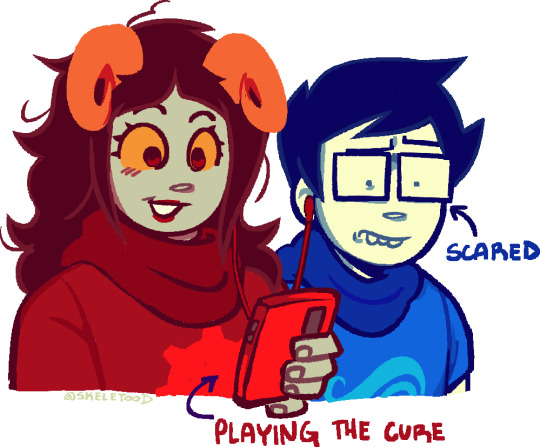
the other day i made a tweet that did rather well where i said, “john and aradia shouldve talked more. its so simple but i like how she actually earnestly answers his questions. so many characters in this comic are so mean to john for just wanting to know more give him a break”
putting it out there now im not big about shipping for the sake of shipping. there needs to be real chemistry. i need to sense that as a reason why two characters would potentially be a good influence on each other. i never knew why i was always so obstinate about this because it’s fictional and not materially hurting anyone, but i think it might be because i’m not sure how to justify it or explain it if not.
i strongly believe john and aradia would have had it made out for them if circumstances allowed it. (what i mean by “ship” or “johnradia” extends to any kind of interpersonal dynamic, even if just a good friendship. it doesnt even have to be romantic, just some sort of dynamic with them.)
unfortunately aradia originally committed herself to staying out of trolling the kids over their timelines, so john and aradia never talked until year 3 on the ship in the dream bubbles but they never had a truly proper one-on-one without outside meddling. i think if john knew aradia better and her story beforehand, she had more time to explain herself and her history, he wouldnt have been unsettled. and also of course if his experience with the trolls didn’t suck so bad because he already had expectations for how antagonizing most of them were.
i found people’s sentiments about johnradia elsewhere too. i remembered that they were both on the song art for ascend, and searched ao3 to see how many fics have been written to gauge how substaintial it’s been in the homestuck fandom. only 17 of them turned up. but the people who do talk about it are either curious about it or really do like it, and that interested me.
clearly it’s pretty niche character relationship to be depicted in any fanwork and i can understand why. despite being so small, from what ive seen it seems universally agreed upon to be nice. i haven’t seen a single person object to it. what ive seen falls into two categories: “wow i didnt think about this before but i actually dig it” or “(starving) finally some good fucking food”

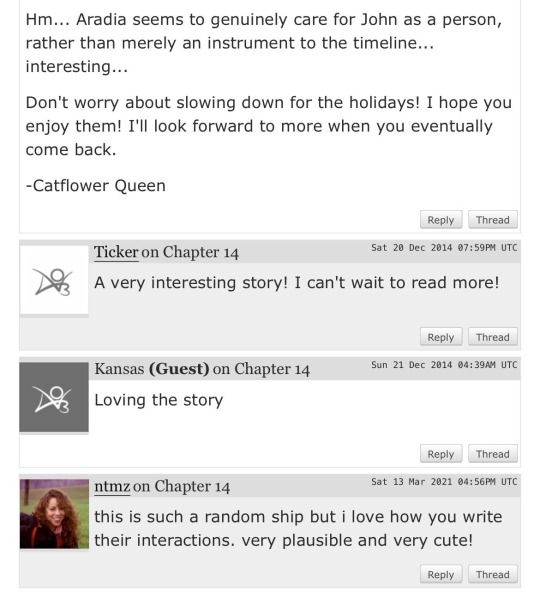


the pattern im seeing is that people think it’s “random”, but i disagree. there is something there substantiating it even if they’re unable to articulate it.
the fanfic these comments are from is chronology of wind. that fic is really, really good, and sadly unfinished. i have more abstract reasons to believe why aradia and john would be good in theory, so actually seeing someone else actually make something with them helped me read it in action, to get a more tangible feel of the dynamic beyond what we have in canon.
i wouldn’t normally make claims about a relationship with regard to homestuck canon by looking at their relationship in a fanfic, because i think you all know by now i am very nitpicky about accurate characterization, and it does not go unnoticed by me when people get it right because for some reason it feels like a one in a million thing (even though it really shouldn’t be?). so this was a special case. the tone was completely consistent with canon. this fic is so in-character i’d basically consider it an extension of canon. to me it’s like they took the same characters and plopped them into this scenario to see how they’d interact. guys… i love that stuff so much. i love fanfiction or fanworks that depict realistic extensions of canon and stays true to the energy and tone of the source, but deepens it. there isn’t enough of it imo. i want to see more of it.
anyway, what i read of their conversations in that fic basically aligned with what i was thinking in my head about what i’d expect it to be like. i was able to compare how aradia and john talked to how aradia and the other characters interacted, their comparative attitudes towards each other—how they’re treated by others compared to how they treat each other.
have you noticed john and aradia’s communication values are both based on sincerity, being in the proper know, treating people fairly, and thanklessly taking on the necessary work that “must be done” in order to have what they really want — a good time that feels meaningful? and they accomplish this without any adjustment in how they talk to each other.
john is always subtly (or not-so-subtly) asking the people around him to answer him soberly and to the point so he knows whats going on and what that means for what his options are. he needs to know to what end he will be applying his absurd energetic drive into making shit happen. aradia honors his time before john can even become uncomfortable with the amount of time being eaten up by conversation. contrast this with rose, who seems to go on for a while with prose-like conversational adornments. in dire situations that need rapid explanation and definitive answers so he knows what to do, this is really the last thing he needs. aradia doesnt waste john’s time. she answers all his questions, and does it politely to boot. his time talking to her doesn't feel wasted.
john's impatience with this sort of nonsense is also why i can’t see something like dirkjohn working out, for example. to me it feels like @entropicbias also deeply understands this on some level because i literally couldn’t have demonstrated what i mean by it any better myself than that. i'm gonna have to to hit him up about how much i genuinely respect that like tbh hes one of the few i absolutely trust to handle writing and depicting these characters in situations and their interpersonal dynamics. and also care about doing their characterization justice as much as me.
of course people are still entitled to like whatever they like, ship whatever they want to. i dont care. but i just don’t think it would work from the perspective of the minds of the canon characters, how they generally think and approach situations. and i can already tell people might ask me how do i know this? what makes me an expert? i’m not more than anyone else is (although i have been called a "characterization expert" from my friends), but i do know that i can pick up on the energetic chemistry between people, including characters, honestly precognitively, without even thinking? like if it’s stiff or tense or awkward, if people aren’t free to express themselves uninhibitedly, if they feel unsafe or uncomfortable. i can sense this almost instantly. it’s something that’s a visceral feeling in my body i cant express and i have to rationalize it after the fact. like i’m doing now in fact writing this big analysis.
> listen to me talk about my special interest boy
for the next section to make sense, you probably want to read this post. i initially started writing it within this post to explain but there was so much brewing i had to explain the context that it turned into something i wanted to post on its own terms.
> okaaaaaayyyyy i read all that
thank you, really. my main point is using the conceptual tools provided by this system to expIain why aradia and john feel nice together and why i’ve seen people positively perceive the idea of a relationship between them even if it seems “random”.
framing them in this system, it wouldn’t be random! there’s a good reason they seem to fit nicely. this is because john and aradia have complementary forms of information metabolism. information metabolism is talked about in this section.
Jung’s psychic types are the types of cognition, or intelligence. But it would probably be easiest to call them types of IM [information metabolism], since the main difference between the types of people lies in their exchange of information with the external world.
Aushra Augusta, Commentary on Jung’s Typology and Introduction to Information Metabolism
aradia megido’s type of information metabolism (otherwise known as a TIM) is LII. john egbert’s TIM is ESE.
aradia and john’s types are duals. you can read more about what that entails here. in theory, their interactions would reflect the duality dynamic. reading chronology of wind, that one really in-character fic that explored their dynamic made me excited because they do!
michael pierce gave an overview of his impression of the characteristics of this intertype dynamic. despite only rough knowledge in socionics while he wrote this, his understanding of duality was spot on to me from my experience and others and i wanted to share it here. (fittingly, i believe he is also LII.)
Now we have the famous duality relationship: in a nutshell, this role is characterized by two traits: 1) a very close psychological distance or intimacy, and 2) a great ease of interacting with each other. It is sometimes described how meeting one's dual can be the event of a lifetime, because it inspires aspects in each party's character that they had never expressed before: the pair may even drop out of society for a time in order to focus on just each other, and to explore themselves through interaction with each other. The curious thing in this relationship is that these parties are rather different in outlook, and when they are not actually interacting as potential friends it's probably more likely for them to dislike or mistrust each other because of how different they are. […] However, when they are able to interact normally, it is a strange and wonderful discovery to realize that the interaction is unexpectedly smooth and invigorating. It's hard for people to describe, but as I understand it: while both parties recognize their differences on the surface, these differences are created by a root structure that coincides perfectly with each other, so that the differences on the surface are entirely complementary and cause no friction at all.
it’s also meaningful to consider that the structure of my own psyche is LII as well. so i’ve got a bit of a bias towards aradia and john.. not in the sense that what i actually say about them is personally biased, but that the bias is moreso my personal attention to people and characters of these two types in particular to see how my own experiences are reflected in them. i really do feel of a reflection of my own thought and work process in aradia and in the more abstract sense she is like an extension of myself. when people say they like aradia as a character i get secondhand joy from that because shares certain specific traits with me. of course i am still my own person though.
these are some of the most apt profiles i've found for these types at a glance. again, think about these characters as you read these descriptions. [from here (ESE / LII)]
ESE (Ethical-sensory extrovert) - john
The trademark quality of this type is a focus on socializing and guiding social situations and interactions so that the people involved can have fun and enjoy themselves. ESEs are typically in the middle of what is happening socially and know about the latest events and what people think and feel about them. They are skilled at bringing people together in fun and interesting ways and making everyone feel actively involved. Their friends know them as people who love life and feel most at home in social situations surrounded by other fun people. In their pursuit of fun-oriented and stimulating social interactions, ESEs typically neglect to structure their own thought processes and views in a way that would help them know exactly what they think and why. They are receptive to others’ attempts to help them introduce more structure and logical consistency in their life and thinking processes. They gravitate most to people who open up to fun and emotional interaction easily, yet are also skilled at systematizing thoughts and views and explaining ideological matters.
LII (Logical-intuitive introvert) - aradia
The trademark quality of this type is a focus on logical, structured thought and generating true assertions and views. LIIs are typically strict thinkers who are concerned that everything fits together in a logical way. They are skilled at understanding, generating, and criticizing logical arguments and instilling their views in the people around them. Their friends know them as people with well-organized thoughts and opinions who know what they think and can elucidate their ideas to others. In their pursuit of logical understanding, LIIs typically neglect their external social interactions and activities that would help them lighten up and experience a connection with other people. They are receptive to others’ attempts to create these fun and lighthearted situations for them. They gravitate most to people who are interested in their opinions and understanding of things, but are also skilled at organizing social interactions and creating a sense of emotional unity.
ive recently consciously experienced the feeling of duality for the first time since i've been communicating with my mom's high school classmate, and it is definitely a real thing. i even remember mom pointing out she noticed when we were all talking on the phone over a year ago that i perked up whenever he said stuff. here is how i explained it:
its bonkers how only once i experience something for myself i’m able to explain in detail what makes it so great based on what my impressions about it were because i tend to have a peculiar way of describing the qualities of an experience. my specialty is deep precision in my analogies for what it’s like. so now i can tell you how conversations with your dual feel… heres the status report. it’s weightless. its so strange. like the topic conversation stretches into infinity that you can pick right back up at any time. it’s hazy and unfocused but still pleasant (unless you’re particularly self-conscious and need to unlearn hiding your true self). but the best parts of it come when you have a specific issue or insecurity that comes with being your most natural self that the world seems to misunderstand about you, or just not give you what you don't even know you’ve been looking for. i think you might mutually intimidate each other at first because you're lowkey both expecting to be made fun of for your inadequacy with certain types of information that the other is nuanced with (and you’re not), but it never comes. you don't feel like what your dual wants in life is wrong. your dual seems so talented in all the ways you hope to shine but you’re always unsure of. for the introvert (me) wishing they felt their own active presence as an object (Se, Ne, Te, Fe) like the extravert does. for the extravert, wishing they felt their own relationships with other objects (Si, Ni, Ti, Fi) like the introvert does. any other intertype relationship (ITR) vs. duality is like the difference between 99% and 100% totality of a solar eclipse, except it’s the level of understanding with another person, like the eclipsing of your own information metabolism with theirs. of course there are other things that influence how well your relationship with this person goes, but i am talking strictly about when it comes to basic communication, the level of understanding you share. sometimes it might feel like you dont have much to talk about or the topic is unfocused, because you two ARE opposites in many ways after all, especially at a glance (domain of interests usually come with specific macroelements. theories about thought structures—like socionics, for instance—are in the domain of intuition, while physical interests and experiences are in the domain of sensorics.) i’m LII in the NT club (researchers) and my dual ESE in the SF club (social-communicative). so they’re constantly providing you with information from their own niche in life that you may be entirely unfamiliar with, but for some reason still interests and relaxes you to hear. you might not feel like you have a lot to say about the topic since but you are fully amazed by this person’s activity. it also makes you feel more sure of yourself and more confident that people truly appreciate and need your natural abilities.
> let’s break it down
here’s some lightly modified descriptions of the information blocks in LII and ESE's information metabolism models from pyatnitsky so you can get an overarching impression of how their type contributes to the informational sphere. i added some of my own adjustments and borrowed some sentences from stratiyevskaya's descriptions. additionally, you can click on the name of the block for an explanation of the role it plays.
i put about a week’s work into these collages but my goal with them was to actually show where i think these information blocks are most pertinent in these characters specifically and where they apply so it’s not just some abstract thing, just as supplementary examples as needed. (for the meaning of these information elements individually you can refer to cysia’s document.)
LII (Logical-intuitive introvert)
EGO (-Ti? -> -Ne!). Analytical thinking. They are well aware of the interrelationships of some objects or phenomena with others, and what laws are in effect or not in effect. On the basis of a comprehensive analysis, they put forward insights about the global essence of specific objects and phenomena, their possibilities. They acutely charge the situation with potential energy. For every situation, there is an archetype.



Super-EGO (-Fi? -> -Se!). Normative ideas about relationships between people and ways to get out of unpleasant ethical situations. Understands ethics as founded on the principles of fairness; to do to one side of the equation that you do to the other. Volitional manifestations in order to protect their living space are carried out only on the basis of personal experience. Because of the limited opportunities to fight back, they react painfully to attempts of any interference in his life. Does not respond to any arbitrary crudeness or volitional pressuring. Does not compromise goals, stubbornly clings to them. Avoids direct confrontation if possible, would rather talk civilly and earnestly. Uses their naturally strong sense of the conditioning of objects over time to avoid collisions with their material interests. Due to this, they may appear as someone with very little weaknesses.
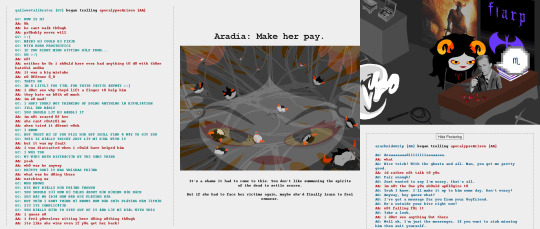


Super-ID (+Fe -> +Si?) Attracts information about a good mood, a specific positive state, or a feeling. They would like to think that they can eliminate serious inconveniences, make the environment around them more comfortable. This skill needs to be evaluated. They are unconsciously activated when there is a need to make the environment more comfortable, which should lead to a better state, raise the mood at least in the immediate environment. In friendly, comfortable, and informal company, their cool exterior thaws and they start lighting up with joviality.


ID (+Te! → +Ni?). Has developed guidelines and methods that relate to specific practical activities, technological effectiveness, and resource use. Spontaneously feels the correct allocation of resources over time, which allows them to effectively solve tasks at an unhurried pace. This pace is deeply rational in nature.



ESE (Ethical-sensory extrovert)
EGO (+Fe! -> +Si?). Perception of the world is fundamentally emotional. Feels the emotional atmosphere well in any situation, knows the relevance of the way of expression, the place and weight (importance) of the internal state in each situation. Flexible approach to solving problems of managing and expressing emotions. They show bright emotionality both negative and positive. Creatively produces around themself comfort, coziness, conveniently arranges space, surrounds others with beautiful things, changing thereby the general condition and mood. Usually opinionated about their tastes.
(wow i really went all out on that this one that tumblr wont even display it in full resolution, so here. john just has so many more lines to choose from, sorry!)

Super-EGO (+Te! -> +Ni?). Practical and technological thinking is tightly based on acquired knowledge and patterns of solving similar problems. Methods of business activity in both general and specific areas are selected based on the opinion of reputable sources, or adjusted to one of the mastered templates. Predicting specific changes in the sphere of their interests is carried out only on the basis of personal experience. He is not able to compare his own method of forecasting with others, so he is sensitive to criticism of poor timing or deadlines, does not like situations that feel like a waste of his time; he is lost in connection with negative events. Guided by purely personal experience, he chooses specific times and deadlines for various tasks with a normative understanding of business activity in general.

Super-ID (-Ti? -> -Ne!). Attracts information about the order, specific logical relationships in the field of activity or interests. Needs someone to suggest specific ways to make connections between phenomena, patterns, and rules. Tries to be reasonable himself, even though he knows that this is not characteristic of him. Sometimes he openly talks of his actions that were poorly reasoned through, as if inviting other people to laugh at his thoughtlessness. The ordering and systematization of thought opens up a new way of understanding of events that are happening around him, as well as new prospects, potential, and capabilities. He likes to think that he understands the essence of a situation and lights up with new ideas. This skill needs to be evaluated. It is unconsciously activated when it is necessary to create order, clear consistency and clarity on a particular issue, especially if their abilities are recognized.


ID (-Fi? -> -Se!). Involuntarily keeps track of communications in their social circle. Without hesitation, they use a variety of ways to establish and maintain relationships that have been developed in his personal practice. Good relationships are important for personal inner confidence in a situation. To prevent unfavorable relationships, they are inclined, often without even realizing it, to act with pressure, forcing a showdown, forcing the partner to change the relationship for the better. Frequently demonstrates his resoluteness, persistence, and purposefulness, as if proposing his behavior as a model for imitation. Usually tells in much detail what obstacles were created before him, and how he overcame them, what he was told in response, and what he replied with, and so on and in the like.


(full res)
you might be able to see already how they would complement each other's thought process nicely. here are some descriptions of what the communication between these types is like:
+Fe! : program function of ESE and dual-seeking function of LII
The ESE periodically tells emotionally charged "program" function stories, telling of how somebody has acted and what they have done. The main orientation of ESE's leading ethical program is: "No one should be offended." The LII carefully listens to these statements, and, demonstrating a full understanding of these issues, develops logical basis for them, e.g. in calm persuasive voice he explains how the ESE has acted justly and fairly. The effusion of turbulent emotions coming from the ESE is counterbalanced by their absorption by the LII, who breaks them down into fragments by asking clarifying questions of the ESE.
-Ti? : dual-seeking function of ESE and program function of LII
The ESE is tuned to accepting information when it's relayed in clear logical form. He issues requests for logical explanations delivered from a point of view of generalized rules underpinning specific life events, which he receives from the LII, who delivers clear unambiguous interpretations, places the dots over all "i's", and demonstrates good understanding of problems that are of concern to the ESE. Not receiving information of this kind, the ESE begins making demands of those around him to be "intelligent" and understand the reasons of his actions.
-Ne! : activating function of ESE and creative function of LII
The ESE feels uncomfortable if he doesn't extend his help to people who are in need of it. His subconscious orientation is: "care and guard the talented", be kind and attentive towards other people. The LII usually meets such criteria by proving in action his aptitude at uncovering hidden capabilities, winning trust, passing on the knowledge. The ESE creates supportive conditions for people who are capable but lacking in assertive "push-through" qualities, among whom the LII finds himself, and a special work regime that protects such individuals from overloads on sensing functions. Newly discovered possibilities inspire and promote the pragmatic and business-oriented activities of the ESE. He can support a new undertaking or initiative with an enormous amount of energy and enthusiasm, light up by new ideas. Only the LII is able to, even having a vague general notion about the subject, construct a developed theory or idea of any issue. This theory shows to be promising in the process of its concrete application within its field.
+Si? : creative function of ESE and activating function of LII
LII tries to take care of their well-being, but may gravitate towards demonstrative asceticism, exhaust himself with work, studies, or exercise. The ESE periodically takes care of creating an environment that "charges" the LII with pleasant sensations: a reception of guests, a good meal, a visit to a theater or a concert, an interesting trip, and so on. At the same time the ESE takes pleasure in this himself.
+Te! : role function of ESE and observing function of LII
The role function of the ESE manifests as business-oriented activity and initiative, supplying interesting information, provision with material assistance to those who are in need, general restlessness and fussy busyness. This function is normative, i.e. the ESE seeks to comply with the norms and accepted ways of doing things. The nuancing of the understanding of these norms, i.e. introduction of activities that go beyond them, is possible only by considering LII's advice and recommendations. The LII serves as a director of this function, adjusting its workings by advocating the necessity of practical application of some beneficial ideas, rejection of useless though spectacular ideas, and the need to ensure standards of life not below average by rejection of equalization.
+Ni? : vulnerable function of ESE and demonstrative function of LII
The ESE poorly feels the flow of time, both physical, which manifests as running late and poor distribution of his strengths over time, and historical, which manifests as poor ability to anticipate consequences of actions and tendency for traditional ways of solving problems. The ESE finds it difficult to make radical choices. The LII fully takes this aspect onto his shoulders. He has an unconscious ability to distribute activities in time, thereby avoiding work stress and overloads, and is capable of making a radical choice. The LII is able to calmly wait and in the necessary moment get to work when the wasteful fussiness of the ESE reaches its critical point.
-Fi? : ignoring function of ESE and role function of LII
On this function the ESE gives advice and makes demands concerning the creation of appropriate psychological distances in form of proper behavior, courtesy and politeness, denouncing rudeness and boorishness. In this manner, the ESE adjusts LII's role function, which in itself contains a set of large psychological distances: a sullen stubborn look, unsociability, etc. With such fine-tuning it becomes easier for the LII to come into contact with people, whereby he becomes more animated, resolves many of his ethical problems that previously frightened him, gains greater insight into human relationships and a more accurate understanding as to whose side to take in situations of conflict.
-Se! : demonstrative function of ESE and vulnerable function of LII
The LII finds it very difficult to exert pressure on other people from his own will and initiative, especially in cases when he needs to attain something for himself. He finds this difficult to do - to press ahead in certain situations, to gather all the required paperwork, to stand in lines and queues, to petition for his own interests, even the ones that are of vital importance to him. He finds it difficult to push a person away, to sharply refuse someone, to quarrel loudly and defend his rights, to put an end to relations that have exhausted themselves. The ESE doesn't directly affect this function, i.e. he doesn't verbally criticize and teach the LII on this aspect, but takes over its functioning completely. The ESE exerts a constant, sometimes intrusive and imposing pressure on other people if there is a need to achieve something, to defend justice and demand fair treatment, to protect interests of those who are close and dear to him. The ESE goes to the right jurisdictions, inspires people around him and directs them towards work and purposeful activity, keeps up a high pace of life himself, and breaks off relations with those who don't deserve trust.
and some miscellaneous excerpts from literature i liked a lot. (i can't remember the sources i used since i've been working on this on and off, for the past week and i was just spilling things onto the post. i think stratiyevskaya?):
Mood - that’s what matters in this dyad - emotions and feelings. Anything that suppresses and overshadows good mood is considered unethical in this dyad and is strongly condemned.
The ESE does not allow the LII to limit him in the possibilities of consuming the amount of pleasures and joys, which he considers to be necessary and sufficient. Fortunately, both partners in the dyad - LII and ESE - are obstinate and unyielding. Both are demanding, unwilling (and not allowing anyone else) to lower the bar of their requirements, unable to give in and make concessions (especially in anything that is of principle for themselves). Both know how to make their partner reckon with their interests and insist on the fulfillment of their demands.
LII is impressed by the emotional generosity of ESE and his spiritual responsiveness. All this finds the deepest understanding in LII, since he is tuned to the same priorities and values. For his part, ESE admires the ability of LII to speak clearly and definitely on every issue. ESE is struck by the harmony of the reasoning of LII, the amazing clarity, accuracy and laconicism of his statements. To ESE it seems that for LII, there is nothing incomprehensible in this world; he can give a comprehensive explanation on every issue. And everything that ESE thought about before is gradually being built into a definite and clear system of views, which he can now very freely and naturally present. Confusion and chaos in his worldview gradually gives way to a stable logical order, as if someone patient and careful was sorting all his thoughts into shelves. Such clarity inspires and activates ESE; he begins to see some prospects for himself, new opportunities. His energy and activity, in addition to emotional and ethical expression, also receives sensory realization: ESE begins to take care of LII and carefully looks after him. If LII is a colleague with whom ESE is especially pleasant to communicate with, he begins to treat him with something tasty, homemade; will make some small, but beautiful and necessary gift (for example: new cologne or a warm scarf).
> okay that's great and all but when are we talking about john and aradia specifically?
yes, that was the point of this post. i just had to build all that up first so i could walk you through my thoughts in a fully substantiated way.
considering chronology of wind again, john doesnt realize it but he needs aradias frankness and insight. even if she’s unable to explicate on vague things, she states the reason why instead of making him feel stupid (it would create a doomed timeline) but thats all john needs to hear. she is self-effacing and only tells him the truth, and we know other people can take advantage of john’s suggestibility in this way. aradia tells john who is or isnt trustworthy, what actions would be useful/necessary and which ones wont, without any selfish personal motive a la vriska or terezi.





^ (juuuust the record my nitpicky ass doesn’t agree with the truth of the classpect interpretation on behalf of the author in the last bit BUT that is beside the point here. the point is that she is answering john’s question in a way that is meaningful for him)
aradia doesnt realize it but she needs john’s friendy goofiness to brighten her up because she is surrounded by people who antagonize her when she’s literally not even trying to get under anyones skin. everybody gets frustrated at her “spooky nonsense” because theyre afraid of their own mortality, basically telling her to put a lid on it because thinking about hard truths makes THEM personally uncomfortable. but to her it’s always just been a fact of life. plugging your ears to reality is ignorance, but at the same time that doesn’t mean there’s no meaning in anything. she wants to help people see this and she dedicates herself to becoming a psychopomp for the deceased and earnestly trying to make people feel emotionally and physically comfortable in their situation through exploring their memories.
john isn’t hostile towards her. by being herself she is immediately able to earn john’s trust when they initially talk. this is also true in canon; the one time they talked when john initially comes up to her, saying “can i ask you something? seem reasonable, and pretty nice.” unfortunately he asked her the one question she didn’t have much to say about, and i can’t blame him for expecting all the troll girls to be basically insane at that point. but i don’t think aradia is insane. yes she is odd, but i think it’s evident that she has a good head on her shoulders with knowledge of the way the universe around her works, and in the end wants to simply bask in watching it play out. i think she deserves to get childishly excited about it, especially considering she was dead for most of her developmental years.
aside from getting his answers answered, john shows curiosity about her and her species and even care about her well-being and state. this naturally comes from their conversation’s ebb and flow. aradia tells this straightforwardly, without bells and whistles and without trying to trick him, unlike the other trolls who seem keen on well..trolling him.. and providing him with unclear answers to those sorts things. maybe aside from vriska, but she did have a little bit of an attitude about it wherein her and john’s dynamic felt uneven or off-rhythm, with a large psychological distance. it’s a different feeling with aradia, however. they exchange information on the same rhythm and so are able to achieve a closer psychological distance in communication.
there are no judgments coming from aradia about john being “stupid”. she doesn’t underestimate him. it’s not just that john wants to understand (although he does), but he needs to understand what he is doing. aradia compliments john about the traits he possesses that allow him to be effective. i guess in a way i’m doing the same thing with john right now.
john is so mobile and strung along by being the action hero going from place to place as a can-do deliveryboy that he never has time to reflect on his losses, think through them, and accept them.

literally who else is more qualified in all of homestuck than aradia for talking to john about these things?
on top of all of this, they have objectively significant connections beyond just mutual self-realization in a way i think could've been fleshed out. there is potential here.
for a story, i can think of a way that a conversation between them could plausibly happen using the systems established in homestuck's mythology. in canon, we see that john never met aradia until year 3 on the golden battleship in the dream bubbles when he goes to sleep.
but john still dreamt out in the furthest ring. that means during those 3 years it was possible for john to have had a dream with her in it, or at least aradiabot. i know john didn't know aradia's name beforehand but let's just explore the possibility that they could have had met before that. remember that all these aradiabots were once this person.
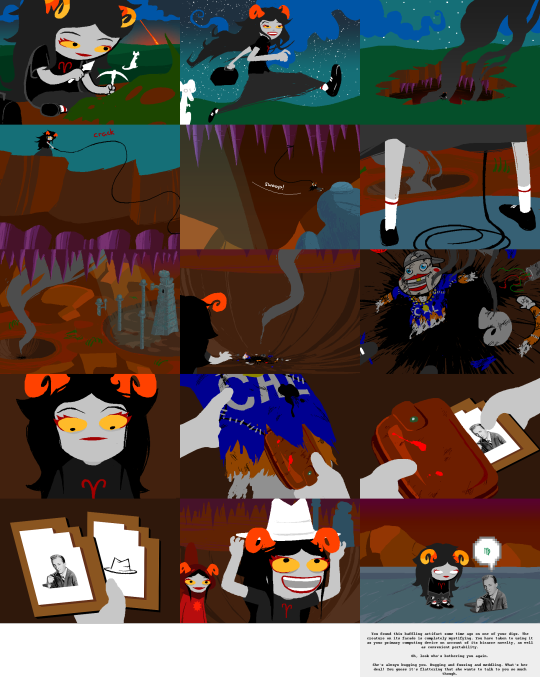
aradia had obtained john's crosbytop, his dads hat, and his wallet quite a while before their sgrub session. theres your entry

imagine john seeing that
memories of dear old dad get stirred up through the link of seeing those items
the dream bubble transforms
john is forced to stand in his memories and explore grief and the meaning of life with aradia
physically being in the space around him would definitely help john reflect easier i think because it will force him to actually exist within the space and talk to someone, taking some time out for this. he wanted to know if anything could've been done or if he was just too late to save them. i know aradia would be able help him slow down and introspect. don't forget the opportunities created by the properties of these spaces that are glubbed out in the furthest ring by the horrorterrors that meld the labyrinthine time and space of their surroundings to the memories of the people and finding others through common points in memory. i would imagine that objects known by multiple people would provide a common point in memory to bring them together.
The bubbles allow the players of Sburb/Sgrub who have lost a life to continue dreaming. The reality constructed in the bubbles is a combination of the memories of everyone inside the bubble accessible to any who has learned the bubble's nature. According to Aradia, it would be quite difficult to exit a bubble to get into a new one, however someone inside a bubble can travel to another one through common points in memory, taking their own memories with them to be integrated into the new bubble. These memories mix and combine, but in general, no new memories are created. Additionally, the bubbles store the consciousness of a player who has lost their dream selves and their original selves, making them double as a form of afterlife; the player is then capable of accessing the memory of anyone else who has gained access to the bubbles. Living players, who have lost or become their dream selves, appear in the dream bubbles when they are asleep. It is in this fashion that the bubbles can be used as meeting places between the dead and the living; even those from alternate universes and doomed timelines can be found in a bubble. Furthermore, in addition to memories, the bubbles can to some extent reflect the thoughts of a player. Beyond that, the bubbles can also behave similarly to Skaia's clouds, showing things that are in some way relevant to the player - such as when coin-flip Dave saw alpha Dave grieving over Bro's corpse - something he was not aware of before being shown it by a bubble.
physically reflect the thoughts of the player…… rubs hands
john and aradia share points in memory related to those objects, and to top it all of they are directly related to john's dad on the same day he died, while aradia grew up with them as bizarre alien artifacts from an archeological dig. the memories are more emotionally charged for john, and i think that distinction would probably be relevant to them both.
to be honest i think after speaking with him for a bit she would readily tell john that she regrets not talking to the kids from the universe her team created sooner before she died, but is glad that she can in the afterlife. in canon, alpha aradia told a doomed dave, "i think its absurd i never introduced myself to you in all that time i spent moping around the lab. guess i wasnt in a very good mood".
now not all the aradiabots would know who john is, because the trolls only found out about the humans once they created the genesis frog and hid out in the lab in the veil from jack who infiltrated their session. the aradiabot in the lab was the last one that survived. so if any one of them would know who john is, it would be the aradiabot that exploded. aradia's dream self ascended to god tier in jack noir's rampage on trolls' derse and took those memories with her which we can assume is what made the last aradiabot explode. its known that any original copy that dies when another rises up becomes a ghost and lives on in the dream bubbles, which would include her. a doomed aradiabot we see in the comic, which was the one that originally landed to alternia in the past, becomes more lighthearted after she dies, a bit more like her alive counterpart.
oh yeah, and the more obvious surface-level connections to top it off? ghostbusters? john ain't afraid of no ghost girl. john would be genuinely interested in what aradia living as a ghost irl on her planet and not as a gaming abstraction in the furthest ring would be like. i imagine she would be able to explain the subjective experience and that she had to prototype herself into the kernelsprite order for her server player to see her. there's also no way john hasn't seen a movie as classic as indiana jones and judging from her poster i can imagine he probably thinks it's sweet that aradia's strife specibus whipkind is a reflection of her own personal tastes, interests and hobbies.
so yeah i've just been chewing on all of this and thinking about it but i know i needed to just get this out there somehow. obviously since i spent two weeks putting this post together i'd be happy to hear your thoughts
206 notes
·
View notes
Text
On Smilodon mouth tissue
Keep in mind through this entire post that this is pretty rough and I don't specifically study sabercats. But we might as well take a closer look at the controversial Smilodon lip and gum tissue and see what it'd look like step-by-step. Let's start with a Smilodon skull (real fossil, not cast) with articulated sabers. Keep in mind the tip of this saber is broken off.

You can pretty clearly see the division between the enamel-covered portion of the teeth and the cementum. In modern felids, this cementoenamel junction is roughly where the gum line ends, and this is also what Riviere and Wheeler 2005 concluded for Smilodon. So if we take that and apply a gumline to this skull, it looks like this:

Now that looks like a pretty deep gumline! The full canines of Smilodon don't necessarily need to be covered by lips; even though they are covered by enamel, it's a very thin coating that doesn't require extensive hydration. This is also the case with the fangs of musk deer and Chinese water deer, who have their canines hanging on the outside of the mouth. These fanged deer, as well as tusked synapsids like walruses and Tiarajudens, have canines that project far beyond the bottom of the lower jaw (see below for the alternative) - and none have the massive bloodhound lips you may see around for Smilodon.

The gums, however, would need to be hydrated and covered by the lips. So that pink line could be an indicator of the minimum extent of the lip margin. But what I notice about these gumline comparisons is that we're looking only at the skull. If you bring in Smilodon's mandible and articulate it so that the mouth is closed...
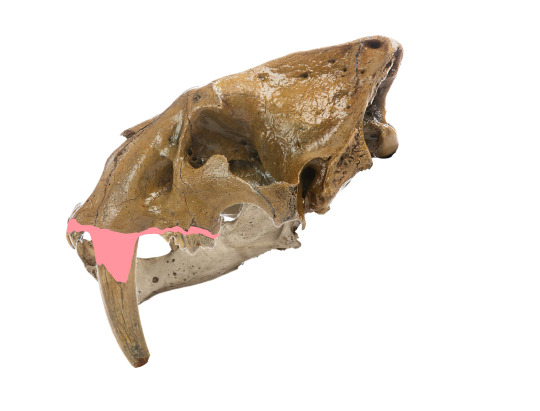
The gumline doesn't go below the margin of the lower jaw. So the upper lips would not need to droop beyond the margin of the lower jaw. And as discussed above, the rest of the canines wouldn't necessarily need to be covered. Goodbye bloodhound Smilodon. This is consistent with how the lips do not droop beyond the margin of the mandible in any "saber-toothed" animal. Fanged deer and walruses have exposed canines. Clouded leopards keep their impressively-sized canines in the mouth; while the lips are relatively big, they don't droop over the lower jaw...

And saber-toothed animals that aren't smilodontines - including other true sabercats like Homotherium - don't actually have teeth that project beyond the bottom of the lower jaw (accounting for tooth slippage). Most of them have a deepened "chin" that follows the sabers. So it's possible, if not likely, that these animals simply had sabers covered by the soft tissue of the lower jaw when the mouth was closed. That would keep the teeth and gums moist regardless of how far down the gums went. Even if the teeth were exposed, the upper lips still wouldn't need to go very far down to keep the gums moist (you can see where the cementoenamel joint is on the Eusmilus skull replica in the lower right).

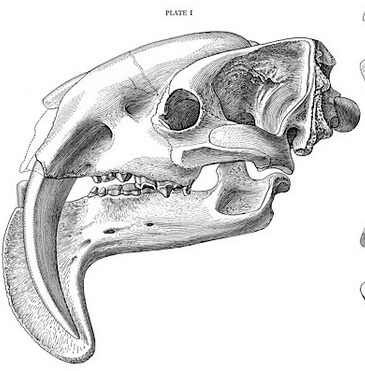

(top: Homotherium; bottom left, Thylacosmilus)
Now let's take the rigorous reconstruction of Smilodon from Turner et al. 2011 - and overlay it over the image above, to see if "traditional" Smilodon lips would cover all of this expanded gumline or not.

That looks like a pretty close match, I'd say! Being generous (and looking at clouded leopards as a very rough guide), I can see the margin of the upper lip maybe going like this. Lippier than usually pictured, but not shockingly so.
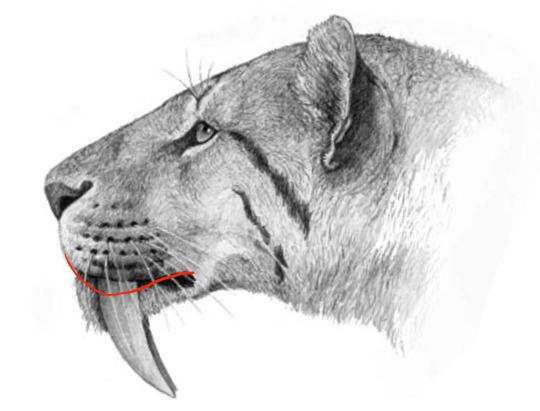
So not much would change.
Now, why would Smilodon need such deep gums? Simple - the longer a tooth is, the easier it is to break off. So more extensive gum tissue would help stabilize the sabers in the mouth. Which makes sense. The current model for sabercat predation is that they would subdue prey using their beefy muscled forelimbs, and only use the sabers at the end for the killing neck-puncturing bite. Don't wanna break them beforehand.
122 notes
·
View notes
Text
How and Why does Madame Morrible (unintentionally) push Glinda to Do and Become Good- An Analysis
Okay, I promised I'd do an analysis of this and hopefully this delivers. Special thanks to @gamorahww because her MBTI analysis of Glinda helped me articulate my thoughts more clearly. Now again, this is mostly based on Wicked Part One movie and Act 2 of the stage musicals, and this might change depending on Wicked: For Good. So here goes:
Let's begin with the How- there are 2 moments that parallel Morrible being the catalyst for Glinda wanting to do actual good from act 1 and 2 respectively- one, where she gives Glinda her training wand at the Ozdust and then during the March of the Witch Hunters which I've already sort of talked about in my other post. Both moments are private, i.e. no one is privy to their conversations even in semi-public areas, unlike the moment where Glinda is hounding Morrible about joining her sorcery seminar. Morrible here (IMHO) shows Glinda and by extension, the audience, her "wickedness" which is revealed in the movie's climax and then later in Act 2 as an irredeemable and calculative antagonist; where she clearly thinks of people as pawns under her control that are disposable once they don't play along to her idea of the "greater good" which is tailored to her needs and wants- in both cases it's Elphaba, first as her student that she "can't risk losing" and then later as a public enemy finally vulnerable for defeat as seen in No Good Deed. It shakes Glinda up on 2 levels- the first one is because no one has done her a kindness which isn't transactional (in this case, instead of Elphaba just putting in a good word for her with Morrible, she put her chance to learn sorcery on the line in order to get Glinda her heart's desire) and in the second act, it's due to the guilt and terror that comes upon realizing how far the situation has gone with Elphaba literally nearing death row and blood on her hands (Nessa and Fiyero). Before Glinda actually does an act of kindness, she witnesses an act that requires extreme bravery and vulnerability- the first is Elphaba channeling her pain through dance and changing her iconic hat from a symbol of shame to a symbol of power refusing to give people the satisfaction that she doesn't belong and the second is accepting her imminent fate and her refusal to take the easy route by letting Glinda give away the truth of her innocence ("I'm limited" and making Glinda promise to never tell anyone the truth). It leads Glinda to learn and experience humanness in it's most naked form, and how it requires empathy and compassion ("she pretends not to" and NOMTW where she's now learnt and told others Elphaba's backstory) and it's Fiyero who first points that out ("she doesn't give a twig what anyone thinks") and then later a Munchkin child ("why does wickedness happen?") that precedes that lesson for Glinda.
Her first act of real goodness, and not performative gestures or activism (her offering to help Elphaba regarding her skin and then with changing her name in solidarity with Dr. Dillamond) is when she refuses to let Pfannee and Shenshen coerce her in stopping to "humiliate" herself and help Elphaba and that makes Elphaba see a glimpse of hope and she lets her guard down. While this takes place on an intimate social level (Shiz university), she hasn't yet made that further turn towards goodness on a political level (as seen in Defying Gravity). This is accomplished in the Finale, where it's Glinda telling the Munchkins, "I'd like to try to be Glinda the Good" and Ariana Grande had a great way of summarizing this part of Glinda that we see in NOMTW- "Was it worth it and how can I now make it worth it as Glinda the Good [...] Because no one is as brave as Elphaba".
So... WHY does that happen?
Because Morrible is a persona of who Glinda wants to be. She wants to be respected and revered as a sorceress, a politician and immortalized as an important figure in Oz. This is seen from her idolization of Morrible as well as her worldview explored in "Popular". It is also ironic that to Elphaba, Morrible is the first "parental" figure who sees her as gifted and not a nuisance (unlike her father and even Nessa). It's a testament to Michelle Yeoh's acting and I know some people have complained about the casting but the way she navigates this fine line is astonishing as well as the way she controls everyone as a pawn... Until she finally is cornered by Glinda and her wickedness is a key factor that secures her defeat. Although Glinda sees Morrible's wickedness as when she publicly declares to all of Oz about Elphaba as a Wicked Witch, it's neutralized when Morrible hugs her and she accepts the hug, because in some way, she's hugging the "perfect" version of who she wants to be. It shows her naiveness and her refusal to change her dreams at the cost of others until in Act 2, when she realizes that even having stuck to her path she ends up literally and metaphorically with nothing, as well as the bitter aftertaste of profound regret that laces the thought that it might've all been for nothing.
Thankfully, she is able to dismantle the pedestal on which she's placed Madame Morrible as both a role model and persona of her dreams, by first taking out Morrible's most advantageous card for control (The Wizard with the knowledge that his own semblance of wickedness cost him his heart's desire- being a father by orchestrating the death of his biological daughter Elphaba) and then later Morrible herself with the same words of advice that kick-started Glinda's journey of knowing the difference between real and performative goodness. And she finally resolves to actually do better, as a way to honor Elphaba's memory and her heart's desire (a better place for everyone in Oz, to be accepted, despite never having that privilege of experiencing it- of course, there was that time before she goes to the Emerald City and post the Ozdust scene where students have accepted and are cordial towards her but that's only because from their POV, Glinda publicly approved Elphaba through their dance).
And that concludes my TED talk!
Before I leave, who would like to know my thoughts on the deleted scene and why (unpopular opinion) it made sense that they were cut which includes a few theories about Wicked: For Good?
13 notes
·
View notes
Note
hiii 1) i would LOVE the post about christian doctrine if u feel inclined to write it bc i don't know enough about christian doctrine to have spotted the issues? and that sounds really interesting + good context 2) this is just silly but that bit in the s2 opening where the mark-figure bumps into another and the head blows up like a balloon and then all the others' heads start blowing up reminds me of hwurmps. i've been sitting on that thought weekly and i think u'll know what i mean
🫶 THANK YOU FOR GIVING ME AN EXCUSE TO TALK ABOUT IT MWAH. honestly i am being a little reductive and its more like a combination of some parts that genuinely reads unsound to me and make me go "oh so you're just using it as a prop, then" while having it also genuinely raising (at least, to me) interesting speculative discussion. (for context i was raised protestant christian, but i dont have formal study nor have ever seriously delved into theology so i'll be real everything i say is vibes-based lol)
my main issues/points of interest:
1) the church's support of severance. instinctually a world where the church does not condemn severance and in fact claims that innies have their own souls is. CRAZILY heretical to me. sooooo many accusations of playing god. though like i mentioned in my tags i) i understand alongside alternate history alternate doctrine could have formed so honestly i'd readily believe if innies-with-souls was the stance of some off-the-rails sect. so that they specifically name lutheran is... interesting to me, at least, and tbh i dont have much more on that lol. ii) i'd be remiss to not mention how capitalism and religion (christianity) are entangled to mutually bolster each other. i'm not knowledgeable enough on this to articulate it much more beyond "well i'm sure it exists", i guess i could point to the prosperity gospel as a more extreme real-life example? anyway this is along similar lines of i), i.e. its something that could develop given the conditions bc of the way systems interact
basically, the church would have to get wack about it to get there but i can see how they might get wack to justify it with the ultimate goal of promoting severance for business reasons. now nothing in the show is actually AGAINST this it very well may be the implication that this is what happened which is what's interesting to me. however severance as a show is not about this so they will not be exploring this in any sort of depth so the possibility that this is meant to be taken for granted as a natural* extension of mainstream* christian logic (*subjective to my own experience, to be fair) is like... i dont know... i dont even care about them bitches but the pedant in me is bursting at the seams. tl;dr They Would Not Fucking Say That (but they could?)
2) burt's motivation for severing (or maybe rather fields' pressure on him?)... i think. i think the "wanting an innocent part of yourself" is. okay enough. cute. but like "i was sinful in my younger years so i think im going to hell for it" is like. WOW THATS CRAZILY AGAINST THE LITERAL ROOT OF CHRISTIANITY? the religion whose most simplest deal "jesus died for your sins so you can be saved so your wrongdoings are forgiven as long as you earnestly believe"????? like no one cares about this but i was wrapping my brain into knots about this. is it that burt still believes his wilful sinning is still ongoing and he knows that he is not a believer still? it seems like he wants to be one to me. is he creating a new self in lieu of repenting and fields is encouraging this? would that not make fields complicit in his sin shouldn't fields be encouraging his repentance instead. maybe it's intentional to make fields hypocritical that way. i don't know and i doubt the writers put that much thought into it so its just something that makes my head hurt. its literally not that serious
3) what arises from a genuine belief of innies having souls. tbh it probably very much parallels the "do children have salvation/go to hell" debate. again, not something i'm informed on enough to talk about, but at least it would be especially salient with the whole innies-as-children theme of the show. but i would also think if innie souls real they should be proselytising innies then because "all are without excuse" (romans 1:18-20 or whatever) so just because they're clean slates their innocence does not guarantee salvation once again christianity is (supposedly) not about innocence or never doing wrong or good deeds outweighing bad it's about faith. which innies would not have. so if the church believed that they have souls they should believe that they are damned to hell also <- and then we loop back to the child debate. but yeah this just annoys me bc innies = innocent and will be saved seems so theologically shallow unless you get into the weeds of supposed innocence re: children. anyway they have to proselytise them for kierism instead so that would never work
tl;dr im literally cinemasinsing the depiction of christianity in severance it's literally not a big fucking deal at all. it moreso just raises interesting questions to meeeeeee but also severance christianity should literally be a sect that is Not Normal Behaviour! martin luther would NOT approve 👎
and also re 2) my god that is funny as fuck i've never thought of that. love it
#why did i call it boring in my original post? thats not what i meant.#i meant boring as in i dont think severance is actually going to engage with this beyond it being a cute little 'hah aint it fucked' prop#because thats not what the shows about. anyway THANK YOUUUUUU#this post definitely could have been way more concise and strongly delivered however that is not my strong suit... sorry
4 notes
·
View notes
Note
Re: Sometimes feeling species dysphoria as someone who doesn't ID as non-human - would you be willing to expand on that? It's okay if not - I don't want to pry - but I've never heard of someone having that experience before and think it might be valuable to the overall conversation.
That said the comparison to cis folks sometimes experiencing gender dysphoria makes intuitive sense to me, too.
Sure! I'll try my best to figure out how to articulate this in a way that makes sense and is also respectful (as someone who doesn't ID as non-human, I obviously do not want to appropriate experiences!) but I do fear it may not be as interesting as it sounds.
This got really long, so I'm putting in a read more, oops!
For clarification, I experience psychosis (since childhood) and have neurological disorders. I think the combination of these things is what causes what I'm about to try to describe, though I would certainly not try to say that the only thing that can cause species dysphoria is this sort of experience, nor would that would make someone's experience any less valid if they chose to ID as non-human if they were in a similar situation. Everyone is different, after all!
Primarily, this thing I equate to species dysphoria manifests as two different things that I tend to describe as non-human body language and non-organic yearning.
Non-human body language isn't as encompassing as I'd like it to be, but it's hard to articulate. My limbs don't feel right sometimes; disproportionate to each other, maybe. My spine feels wrong; too short, maybe? That could be the scoliosis causing both of these things, but it happens in my arms sometimes too. I don't know what it wants to be, however. There's ways my body wants to move to convey ideas to others than I can't emulate properly. My vocal mimicry is good, but not good enough, though I wouldn't really tell you what calls I'm supposed to make. I do trill a lot, when I can.
My teeth aren't quite sharp enough, I know that. And would a tail help? Would upright, pointy ears? A crest of feathers? I wouldn't mind a crest, I think, but then the moment passes and what I have is... acceptable. Fine. I am here, in this place, and my nerves are made of fire.
In a more permanent fashion, I bunt people to show my affection, but even when I physically can't it is a constant urge. (I nearly broke poor @/sattarehi asking if I could bunt him.) It's easier to move on all fours sometimes, or just in ways that are unintuitive to a human blueprint. To curl around people while we're sitting on the edge of a bed, them sitting up, me on my side to encircle them, in a way I don't see others doing often. The way I hold my arms sometimes feels like the resting position of something else; holding them at my sides like a person is expected to feels wrong, like it'll impede my ability to flee if I need to. (From what? Is that the paranoia? The hypervigilance? The nerves again? The various and sundry neurodivergencies?) When I'm socially allowed to cross my arms it helps, but it's not quite perfect.
Sometimes, the fact that I cannot do these things more effectively (though my brain does not grant me the knowledge of what that would look like), that I am considered eccentric and strange for doing them at all, pulls at something in me that doesn't speak in any language I have access to.
As an aside that may only slightly be relevant, my social integration is interesting. People who are friends or close associates or even people I think of fondly become extensions of us in a way that isn't so much possessive, but in the same way a tight knit family group might be among certain animals. (Which is why when people ask 'do you experience romantic love?' I can't honestly say. This is already quite intense, you want me to try and define it further?) And that's to say nothing of the prey drive. The human prey drive is intense enough, and I can certainly repress it well (I can't believe PvP games were good for something) but mine feels a little overtuned.
... So the non-organic yearning is fun to try and figure out, but it provokes the same feelings, so I'll try to articulate it just in case it helps!
It feels like I am made of something deeper. Something farther. Here, there, everywhere. I feel like I am floating adrift in a dark sea, unable to drown or sink, though surely I must. Surely I must. And yet.
It isn't an invincibility. It isn't a belief in a higher power or an afterlife. For the sake of my health, I cannot believe in these things. (We shan't talk about my childhood delusions, but they were quite elaborate! You could tell I was into world religions as study subject as a child.)
But sometimes I look into the sky and feel it staring back, like I am stuck in a Polaroid that an old friend keeps looking at to remember me. I look at pictures from all of our instruments that turn into the infinite dark beyond our planet and my brain thinks I want to go home the same way I do when I see my hometown on a map. I am not from here, something in me insists. I am from nowhere, but I am certainly not from here. Is that the intergenerational trauma? The thing that infects you and fills in where your grandparents' language and food and culture is supposed to be? The remains of what a war before you were born left behind? Or is it something else?
It feels like something else, the same way sometimes my body feels wrong in the same, but different, way that it always feels wrong. It feels like whatever I am, separate from this meat suit and these mutinous neurotransmitters, is from somewhere else. That it knows this. That it wants to go back.
Not all of my body dysmorphia is neatly gender dysphoria. Species dysphoria, as a term, helps gather these experiences up neatly, even if I don't identify as non-human. I am human. I am a strange, eccentric human, even if I feel like Something Else Wearing A Human Skin, but ultimately human regardless. Despite that, almost. Maybe, in a strange, contradictory way, I'm both. Human is what I want to be, at the end of this day. But regardless, it does help me understand things a bit more than someone who doesn't have the same experiences, I think. And maybe this will change in the future as my understanding of myself grows! I'm a whole adult, but I'm growing every day, you know?
(You know that book, Casual Rex? And they made it into a show pilot/TV movie called Anonymous Rex? And it was about dinosaurs barely surviving their extinction and pretending to be human and they wore disguises to blend in? There's a scene where a character describes another character as "she's a human pretending to be a dinosaur pretending to be a human!" Life feels like that sometimes.)
#sparkylurkdragon#vex talks about things no one cares about#species dysphoria#i hope i'm at least sort of eloquent here#instead of taking time to think about this i just vomitted it out there
13 notes
·
View notes
Text

I know I've mentioned my love for Iron-Blooded Orphans before... Unfortunately those kits are pretty hard to find these days, so I'm stuck building stuff I don't love. In this case - that's the Gundam Barbatos Lupus.

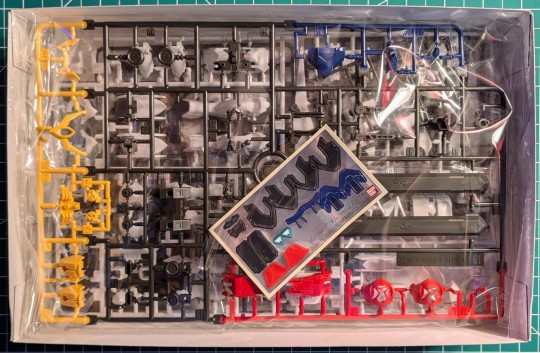



I don't love the Barbatos Lupus. My favorite is just the good old fourth form. I mean, I like the big sword mace... But, for the most part, Lupus just looks overdone to me. Too big and bulky.

This is where things started to go wrong with this build...
I don't love color-correcting stickers and I might normally opt for paint. But these stickers had little metallic details that I thought might actually look good. So I decided to try using them while leaving myself the option of going back to paint later... Which meant I wasn't going to do my usual gluing and tightening for an IBO kit.
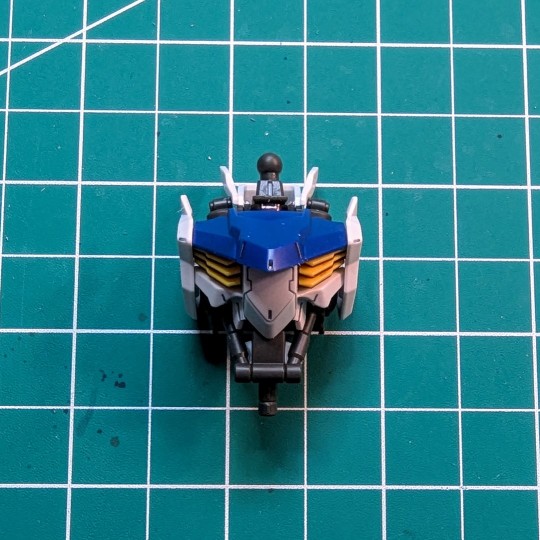
Right off the bat, this torso section feels all kinds of loose and wobbly. I'd normally tighten it up some... But, again, I don't want to do anything permanent because I'm thinking I might want to disassemble the kit to paint it later.

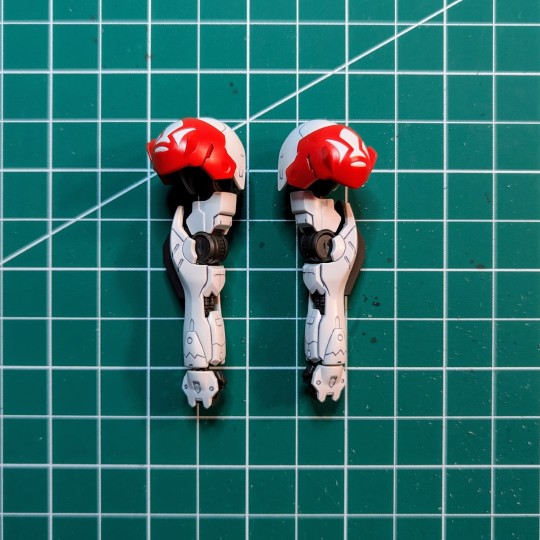
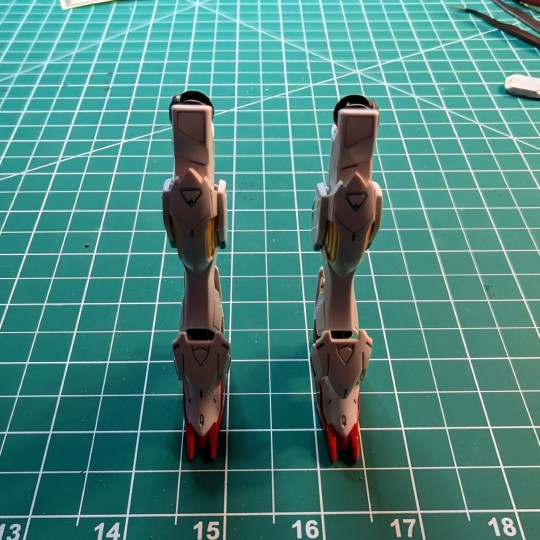
As I've said before - one of the fun things about building models like this is getting to directly experience the physicality of the thing. In this case I'm building Barbatos Lupus starting with what I think is the exact same inner-frame that Barbatos used... But then there's these little extension pieces that go into the arms to make them longer.
And, again, the gigantic feet I keep seeing with these IBO kits.

And then things went really wrong...
I spilled my Tamiya Extra Thin. I didn't really do too much damage to anything, but I got a big thumbprint on the sword mace. So I had to sand that down.
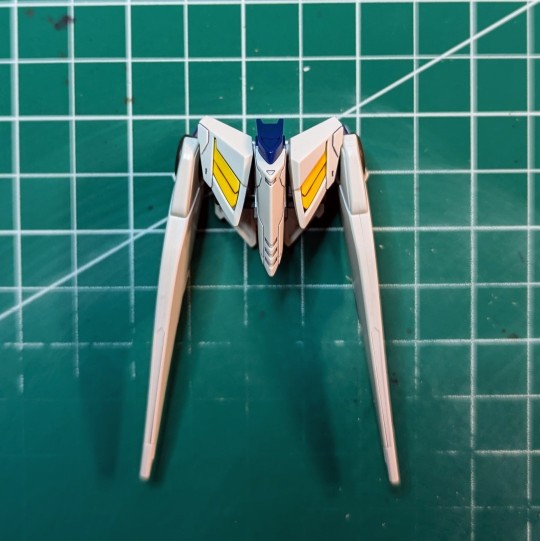
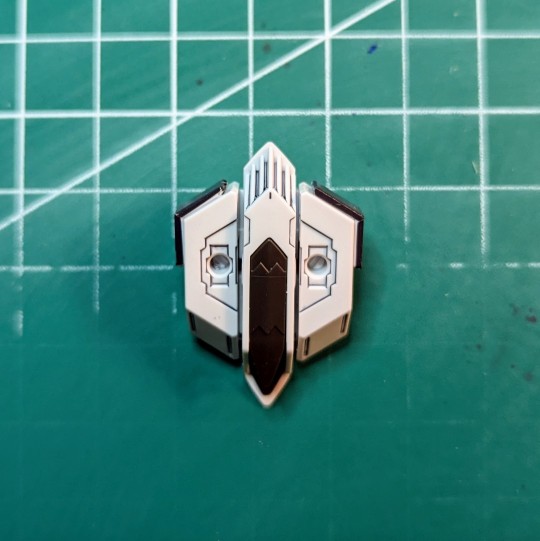
This is about where I decided I was really going to have to paint this model eventually. The stickers just looked bad. Lots of edges and bends to fold and they just don't look great. Sure, from a bit of a distance they'll be fine... But I'm not happy with the results.
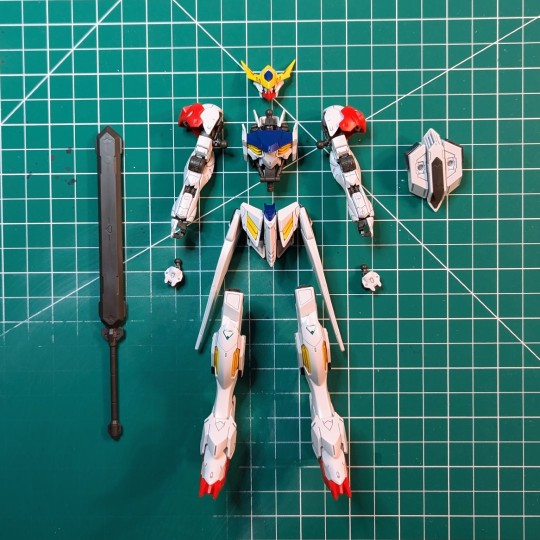

Not a lot of accessories in this kit - just the sword mace and a couple alternate holding hands.
A neat feature of this kit, as opposed to the standard Barbatos, is that the backpack actually has articulated arms. Not that I'm likely to really use those arms for much...



There it is - all built and posed. And I'm really not thrilled with this build. The kit is fine, all things considered, but it really needs a little extra effort. I really need to tighten the joints and replace those stickers with paint. As it is now, it's floppy as all hell and barely holds a pose. And the stickers look absolutely terrible up close.
16 notes
·
View notes
Text
so! gaem progress update!
finished up at the githyanki creche yesterday, with much save scumming and poking through guides, got the elminster bit, then wrapped up act 1 and sprinted to Isobel
so! did just enough to get Vlaakith and the inquisitor to betray us and most importantly Lae'zel, then gently prodded her along towards "hey your evil god queen sucks, actually."
Adana really WANTED to kill her dream visitor in the prism because she's EXTREMELY pissed it's still wearing Adran's face, and if it had ONLY risked herself to do so, she might have called its bluff and stabbed it. As is, the combination of "this could screw over my friends," that stabbing it would mean having to deliberately choose to stab her perfect dream of a boy, AND it pretending it wasn't going to fight back was enough to stay her hand. she still loathes the bastard and DEFINITELY doesn't trust it, but the risk is just Too High for her to call its bluff.
I think bards and wizards just have juvenile rivalries in general from both being arcanes who have to go to college, but Adana I think takes hers a littttttle farther than most do. Condescension is a BIG fat red button of hers, and unfortunately it is the habit of wizards to be the Worst in that way, so.
also had a funny realization the other day that Adana VERY easily could have been the bard equivalent of Gale if her upbringing had been a bit more supportive and/or religious, and a bit less of her being dehumanized into alternatively a Tool To Be Used or Extension of Her Mother without wants or a mind of her own. she WAS a prodigy as a teenager, and in that arena the Hubris and Ego were DEFINITELY in the right league to think she could fuck with gods-- once upon a time she WOULD have bet her soul on it, without hesitation. but nah.
as far as the devil's bargain Elminster brought, she found the man insufferable in general but tried to play polite host bc girl Does Not go around making powerful enemies if she can at all help it
and well. Adana has a mild death wish and a mile wide self-sacrificing streak. if she could Guarantee she would be the only casualty on their side, she'd suicide bomb the absolute in a heartbeat. Cannot articulate why it's okay for Her to feel that way and not Gale-- she doesn't even have forgiveness or a particular goddess's embrace to look forward to, she's largely Played the Field as far as pantheons go, except for the times she Explicitly pissed off Bhaal as a teenager (on purpose!) and Accidentally became a special favorite of Loviatar. (as a joke.) nothing to terribly pleasant to look forward to. Mostly mumbled mealy mouthed promises that they should keep their options open and that she'd support him no matter what, but it'd make our friends sad if you died, yeah?
she has done zero self reflection and she has learned Nothing, lmao.
very funny that as soon as you get into the Shadowlands you can pout at Shadowheart for not paying as much attention to you anymore :(((((, so I Did click those options just to get rid of them even though Adana would a) rather die or b) have been drugged, tied up, and edged for HOURS before she would even DREAM of being needy like that.
Raphael being at the inn was fun! Adana has grown enough confidence that her response to seeing him was Rage and not fear. Adana is the way that she is because she has Deliberately reforged herself into the sort of person she so desperately wanted to Save Her as a child, so Raphael w Mol and Marcus w Isobel both IMMEDIATELY hit berserk buttons for her. No, fuck you, GET OUT, get away from them, I'll kill you.
Karlach approves!
Isobel is VERY funny, I didn't expect her to come across as so bratty or showboaty at all from what I'd seen on my dash and in wiki diving, but I and Adana were both quite charmed by the funnee ladee, I like her quite a lot. I suppose I shouldn't have been surprised though, takes a fair amount of ego to Pull a demigod, lmao.
and now i have to go back and talk to everyone and everything at the inn before going to Isobel bc i just sprinted there and missed a Lot, whoops.
5 notes
·
View notes
Note
Hello glitterypin! Sorry for this random question. A short while ago I rewatched Doctor Who and got really into the 12th doctor (and Peter by extension). I remember liking his Doc but unable to really articulate the reason but rewatching those seasons years later pretty much blew my mind, and the depth of his performance is a large part of it. I've been going through his TV and filmography since. Anyway, I saw your post about the PCap fan tumblr community and was wondering if I could get an invite? Just got back into tumblr recently so this might be very, very late, but I thought I'd give it a shot!
Hello there!
Of course you can join! The community has now been made public and is open for everyone to join without an invite and it even shows up under the Peter Capaldi tag (and several others of my choice).
This is a good chance for me to plug our new weekly event, we're calling it PCap Recap and it basically means that every week we choose one thing to watch and then spend the weekend massively posting about it. This week we're watching Local Hero if you're interested!
Looking forward to seeing you around! ☺️😃
5 notes
·
View notes
Note
I'm in my mid-30s and my ever-growing love for history has spurred me to consider a career change into the field. I'd love to work in a museum or archive in a research or curatorship role (rather than as an academic), and I live somewhere where I could take time out to get a masters degree.
From your experience - is a change like this feasible? Is there work available? Will a late (re)start be a hindrance to getting a foot in? Is a degree worth it, or should I aim to get volunteer experience instead? Or am I better off sticking with my current decent office job and treating historical research as a passion/free-time activity instead?
This is a great question, and I wanted to give you as good an answer as possible so I outsourced to a friend and former colleague who worked in collections. This is what she had to say: *follow the Emerging Museum Professional FB page. There is lots of advice there
*I don’t think it’s ever too late to follow your dreams. You’re in your mid-30s, not 99! (Although even then I’d say go for it!)
* I’d recommend volunteering at a place you would be interested in working in. It’ll give you a better sense whether or not this is actually a field you’d like to get into, or just a fun hobby. Both answers are totally ok
* I’m a fan of experience over degrees, but it really depends on where you would want to work. Many positions require a masters degree, but not all. If you are in a small town, or more rural area, it would be easier to talk your way into a position than if you are in a big city
* if you’ve loved history for a long time, try to articulate how skills you have in your hobby or through your office jobs relate to the museum field. I used to manage cafes and found that many of those skills transitioned into collections management (inventory, databasing, customer interactions, etc.)
Best of luck! ---
I will echo her point that it's definitely not too late and if it's something you're truly passionate about it's worth at least considering. Obviously it's not always that simple - giving up a stable, decent job is a risk etc., so while I'm generally not a fan of volunteer work, it might be worth trying it just to see if it's something you would like as much as you think. I will also agree with her point about experience over degrees. I've never been to college at all myself, which is a huge rarity in this field, and when I got my first museum job my only work experience was running a salad bar at a restaurant. But my supervisor told me, years after the fact, that part of why she gave me an interview was that in my cover letter I made an analogy comparing running a salad bar to being a historic interpreter: something about how being in the middle of the dining room meant the bar and by extension myself were always on display, and how that would mean I'd be more comfortable with thousands of guests seeing me in period clothing etc. Granted, interpreting is very much about talking and making analogies to help guests understand the past, so it's a bit different from the behind the scenes work in how those skills translate, and how demonstrating an ability to talk is directly related to the work itself, but still. I hope this is helpful, and I hope that if you do decide to pursue this it works out how you hope! Thanks for the question!
25 notes
·
View notes
Text
Zoe, Varsity Captain
I found where I put her!
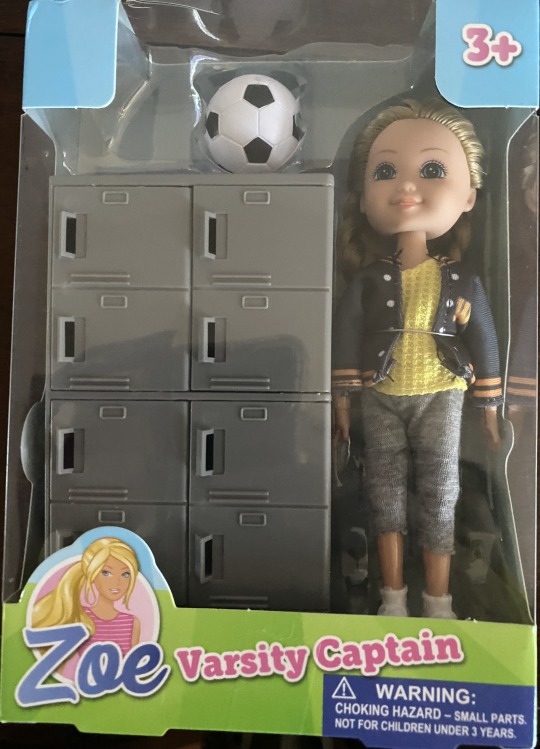

I keep my smaller dollhouses and all my fashion dolls in a pair of big white cabinets with doors. Turns out that I had shoved Zoe's box in sideways next to a dollhouse painted the same blue as the box edge, in a space where I thought only a miniature taco truck fit. So here she is!
Zoe is a find from Five Below a couple months ago. At the time, she came in this blonde version and in an Black version. The faces were the same, and I impulsively went for the doll who looked like I did as a child, though I was never that athletic. Her brand is Brooklyn Lollipop, which is a real brand with its own web site (as opposed to the kind of white label brand that exists only to slap a name on a box). Alas, Zoe is not currently on their site, only Sophie (an ordinary Barbie clone) and Sophie Sixteen (who is not a teenager, but an Evi Love clone with one Chelsea-sized girl).

For a minute or two, I was worried the locker didn't open. I actively want the locker as storage! However, some pushing and prying did the trick.


Here she is! Zoe is a skinny girl with a large head, and overall pretty cute.
At some point, I thought she might be the same size as Kid Kore Katie. Obviously, I was very wrong about that. Kid Kore Katie is about 8 inches tall (classic Skipper). Kid Kore Jodi is about 5 inches tall (slightly larger than classic Kelly). Zoe is in between. So while "varsity" implies high school sports, she would seem to be about seven years old.

I bought Zoe for her extensive articulation! She has knees, elbows, and wrists -- that's all unusual in her small size. She cannot touch her (flattish, very Sparkle Girlz) face, but she can post a lot. Oddly, she does not have molded underwear. I grew up in an era when dolls didn't, so I don't care.

Zoe's tiny clothes are pretty good. The sweater and jeans are constructed as a single piece, which gave me an idea. Can Zoe wear the Four Friends clothing from Dollar Tree that I use for Evi Love and other taller, sturdier toddlers?

She totally can! Even the shoes are a perfect fit.

In fact, the dresses that look wrong on Evi Love because they're too long for a toddler fit Zoe perfectly!

Zoe is definitely a different species from Arvin Lebec, my Mego Lion Rock war hero.
Then as I was fiddling with photos, I realized that (a) I'd probably bought her to fill the Chelsea "larger than a Kelly" niche and (b) that would make her a peer of Creata Today's Girl Hilary.
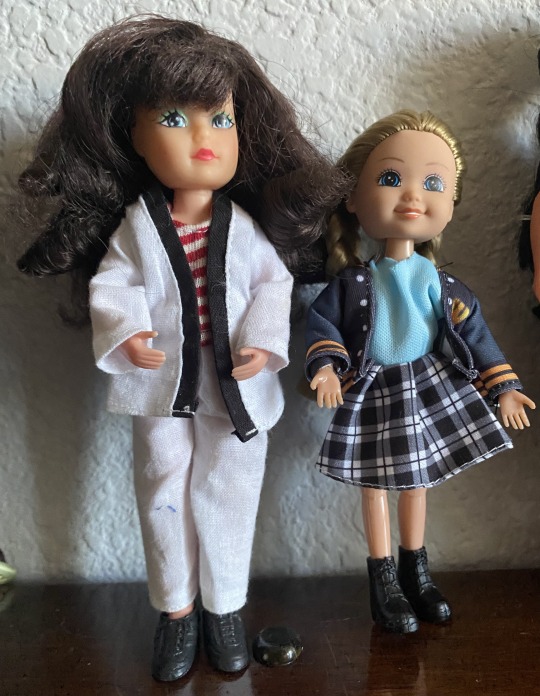
Or... not. No, I have somehow managed to acquire a uniquely sized doll with a large head, which is high on the list of "things I will not do," but darn, look at that articulation!
Here she is with a crowd of variously sized young girls, including Emma Dreams, the "looks like me as a kid" pick from the demise of 99 Cents Only.

2 notes
·
View notes
Text
Long-term goals (again). June 2024
Since I want to be able to do a translation and interpreting course, and find some work in these fields, I think it's important for me to understand what I'll need to do to get there. This post will attempt to highlight the skills i will need, in an optimistic kind of way.
Listening
The ability to understand many varieties of Mandarin as spoken throughout different parts of China and Taiwan, at formal and informal registers, and with varying speeds and with contemporary words thrown in. I don't think I really need to work much on this apart from just finding opportunities to use Mandarin (i.e. people to speak Mandarin to).
Reading
The ability to read extensively and intensively in fiction, non-fiction (news articles) and everyday language use (blog posts, emails, online questions and Wikipedia for example). It might also help to understand more formal kinds of Mandarin, or even Literary Chinese at some point in the future. This is also a skill I personally want to cultivate for its ability to enrich my understanding of contemporary Chinese fiction. Currently I'm still working on building up a basic understanding of grammar and characters. I'd estimate my reading ability is roughly at HSK 3 level now.
Speaking
I always feel like I'm not quite able to articulate myself as well as I could with Mandarin. There are some basic words or expressions missing a lot of the time, and some sentence constructions come out unnaturally. I want to be able to speak like someone who's finished high school /in China/ by the time I sit an interpreting exam. This means being able to grade my language and speak in both informal and formal registers.
Writing
This is probably the hardest skill for me to learn, as there are many idiomatic ways to use Chinese, and I'm not really there yet at all. Constant exposure to exemplar writing and the ability to pick from a wide variety of known vocab would help here.
Current goals
I think my main goal is to assimilate enough vocabulary to speak a bit better and not have to rely on English so much. With this in mind, I want to finish 4 Chinese printouts I currently have that I /know/ are good quality. I'll make this my goal in July to finish all 5 (half of one takes about an hour, so in total this should be 10 hours of study).
I also want to prepare my vocab before I call my parents if there's any words I definitely don't know.
I'd like to have reached all of these goals by the time I finish up at university for linguistics (probably mid-2026).
0 notes
Text
Holy fuck a pinned post.. It's one of those pinned posts isn't it





What's up gamers I post Rain Code (literally just the peacekeepers) (it's a Yomi world no mercy). I don't tag spoilers so do with that what you will
Names include: Seth, Feliks/Felek, Sójka, Mikołaj/Miki, Stefan/Stef, Wojciech, Kazik/Kazka and Sol. I collect names like cool rocks, you can basically pick and choose on which ones you use to refer to me on any given day, I don't really care. He/it/xe exclusively (for Yomi), and yes, they/them IS misgendering can you not pleaseee *looking at you with my big wet eyes*. On a similiar note, I'll prefer to not be referred to with any feminine terms like ever, I don't care if it's a joke/slang/whatever. "girl" isn't gender neutral guys what the huh I am going to become the joker

Yomi Hellsmile fictionkin* in like, the serious/metaphysical way. (Can't believe Yomi got real and is now prowling around somewhere in the bowels of Eastern Europe that's so cool right). That's also why I drop the I/me oftentimes whenever I talk about Yomi, in case you were confused about that.
I'm generally pretty hesistant to interact with people that also call themselves kin (and especially "kinnies"), as I'd rather not involve myself with the kff crowd or other people that treat being fictionkin as an extension of fandom, and unfortunately I can't always tell whether somebody is using it in good faith or not, but I don't like to assume things about people based off of very limited information like a few posts, either. Where was I going with this? Basically uh, having my eyes pried open and forced to witness late 2010s (fiction)kin drama has turned me extra sensitive and it's day 2137 of me telling people to please look up what being otherkin even means before using it for themselves I'm begging
If anybody has questions of any kind concerning the whole thing (whether it's purely for info's sake or more personal) then I'm fine with answering as long I'm given basic amounts of respect (no calling me a kinnie, no making me into a punchline, no making weird assumptions about me based off my kintype, no getting weirdly personal about it if you're another fictionkin from my source??)
*only concerning yomi, who might either be a fictionkin/fictive/who cares since apparently we're actually plural. uh oh. pinned might need further revisions but also im perpetually tired so. Later

Very often I have trouble with memory and articulating myself and whatever I write may end up looking a bit weird or just near incomprehensible and unfortunately there's nothing I can currently do about it. While I love receiving them, I might take very long to forever to actually answer an ask due to either low energy or anxiety. This should should go without saying but if you make fun of me for it like ever you're getting hard blocked into the sun
I'm autistic - don't tone police me. Sometimes I can't read sarcasm or playful rudeness. Don't expect me to understand or tolerate it when you start insulting me as a "joke", my autism & NPD wombo combo makes me really hurt by that sort of stuff. Or just. Don't expect strangers in general to be fine with that?? I kind of hate how normalized just being mean to people ironically has become.

I don't do "DNI"s as they're just objectively pretty stupid and ineffective, and just block people as I see fit. Instead, if you're curious about those, here are my boundaries under the cut which are optional reading - but might be helpful if you'd like to avoid getting blocked over accidentially crossing some of them:
I get very anxious over people leaving their negative opinions on/getting aggressive over Yomi under my posts, trust me I don't need nor want to hear it. You can go hate him literally anywhere else, why are you doing that here.
Nsft stuff might occassionally be referenced/discussed on this blog, but please never leave weirdly sexual asks/tags in relation to Yomi/me, even as jokes. It makes me incredibly uncomfortable and I will block over it from now on.
(continuing from above point: these sorts of comments are still usually perfectly fine to leave on the yaoihellsmile blog)
If you're wondering, or about to ask as to why I might have you blocked: I block very liberally over all sorts of stuff no matter how small, so I most of the time probably don't even know either.
I don't check carrds, sometimes I don't check pinned posts either. If you don't want me going through your stuff, the block button is simply the best way to do that. No hard feelings, I promise
If you bring up shipping discourse I'm compressing you into a cube. It's 2024 who fucking cares over which pixels you draw making out none of this is real consider logging off and caring about some actual problems
Probably will add onto those in the future. We'll see. anyway...

You're getting a krówka for reading all that👍👍

5 notes
·
View notes
Text
•
#littletalks.txt#went out with a guy (casual friend) a few weeks back and I wasn't sure about it at the time bc#I like him but he's like Velcro#which is fine except that I am very much not#and so like the date itself went pretty well but I was a bit overwhelmed by *things* and then he had finals and I've just been#having my ass kicked by the big sad‚ so we hadn't really been able to see each other much since#we play magic the gathering with a group on Thursdays and Sundays which is how we met (and then there was a whole thing with a-#Halloween party which really was more of an inciting incident but I'd been catching feelings lowkey for a minute but I digress)#but he hadn't been at magic too much recently bc‚ again‚ finals. but they're finally over for him so he was there yesterday and I wasn't#[I was there‚ idk why the tag ended like that probably lost my train of thought]#and we sort of ironed things out. he's a good egg I think#very attentive‚ he notices things. I have a hard time verbally articulating things at the best of times and he picked up on it and we#conversed over notes app for a minute trying to clear things up#biggest issue is physical touch#touch is like his big love language‚ he just loves to cuddle‚ which is great except that I am easily overwhelmed esp in social situations#my main love language tends to be quality time which is where the confusion I think came in#bc for him touch is for its own sake whereas for me it's an extension of being present with a person‚ a physical sort of ''I'm here!''#but we were in a loud situation and I was very overwhelmed and couldn't figure out how to word it well so after trying for a minute (badly)#I ended up just going ''you know cats?'' which to his everlasting credit he understood almost immediately#all of this is to say that I think this might work out?#idk I just have to get this off my chest and the trusty old blog is like my stupid little diary lol
1 note
·
View note
Text
(There's videos now! And there are some observations, extra pictures, and silly prose below the cut. Enjoy! And let me know if there's any particular angle you want to see this guy from.)
youtube
youtube
---
The Summoner's journal continues on the following pages, along with a collection of... moving photographs? How did they manage that?
It's been months since I last wrote in here... I've been so swamped between keeping the Order's operations running smoothly and working with the younger Grima. It took a long time to convince him to let me bring a healing stave near him. I don't know why they're so afraid of staves - they still haven't quite figured out how to speak in Askran, though they're trying, so they can't really tell me - but you don't rush things with dragons. His wounds were so much more extensive than we thought at first... But he's on the mend now. That's what's important.
Observations of Note


There's a lot that's odd about Grima's physical construction, but one of the most bizarre details to me is their rear limbs. Seeing them at rest you might assume they're a fairly standard mammaliform digitigrade hind leg... But the knee and ankle joints can bend side to side, in addition to the back and forth angling you expect. Frankly the entire limb and hip structure looks like a pair of human shoulders and arms attached backwards. I'd be curious to see how that works, skeletally; I wonder if x-ray tomes are a thing.


The anterior and middle segments of his torso can articulate! Clearly he doesn't have one solid ribcage for both sets of arms, as I'd thought before. His arms are as odd as his legs. There's a marked similarity to the arms of a human or bird's arms in the hand, thumb, and elbow; but there's an extra joint between the true shoulder and the elbow. A false shoulder? Doubled shoulders? Extra pair of reversed elbows? I'm not sure how to classify this.
Extra Photos






Now that they're physically healthy, and much more used to me, I've found they're actually... surprisingly playful? Whenever I come back after being gone in Askr a while they swoop around so cheerfully. For some of these photos I "asked" them to pose for the tome by doing charades, and they actually LAUGHED at me for it one time.

Introducing them to other people is... slow going, to say the least. They won't be aggressive if I'm nearby, but they won't interact with newcomers either. They just go sit on top of the pillars and start threat displaying... I'm not sure what I'm going to do about them going forward. Do we let them outside here in Archanea? Do we bring them back to Askr...? Surely there's a place for him in his own world that doesn't entail so much tragedy, but it's hard to know how to equip him to handle everything he'll face out there. And it's not like I know a lot of successful dragon parents to ask for help with this. Ugh.
An Anatomical Reference of Grima, ca. 608 (Archanean Calendar)
(In essence: I got my claws on Grima's model from Echoes, and took screenshots of it in blender for your art referencing convenience. At some point later I'll reblog with some gifs of his animations if I can get them working. Enjoy!)
---
An excerpt from a worn journal attributed to an unnamed Summoner of Askr. Carefully affixed between paragraphs of chicken-scratch are several large, high quality photographs.
With the assistance of the dragon Askr, I've finally opened the correct gateway; one leading deep within the Thabes Labyrinth just around the time of the hero Alm's adventures. And it was just as the old manuscripts claimed! At the heart of the lowest levels, we found The Creation - he who would one day go on to be known as the Fell Dragon, Grima - laying in a deep torpor to conserve energy. It's taken near a month of work, and I've no doubt the rest of the Order thinks I'm nuts by now, but with a lot of one-on-one talking and the offering of several cart-fulls of quality carrion for him to eat, we've at long last built up a mutual trust! He's not quite at the point of letting any of us touch him, not even me; and he outright panics if he sees someone carrying a stave. As such, any real investigation of his physical health and detailed characteristics will have to wait. But he tolerates my flitting about with Anna's picture tome well enough, and has allowed me to take enough photographs and rough 3D scans for us to get a sense of his external anatomy. Once he's regained enough strength to move and levitate without undue difficulty, I hope to capture some short video of him in motion...
Full-Body Shots
His wings and horns are proportionally quite small compared to the much older instances of Grima I've dealt with thus far. Is this just because he's so much younger? With how much time he's spent trapped down here, it might be malnutrition stunting his growth, too...
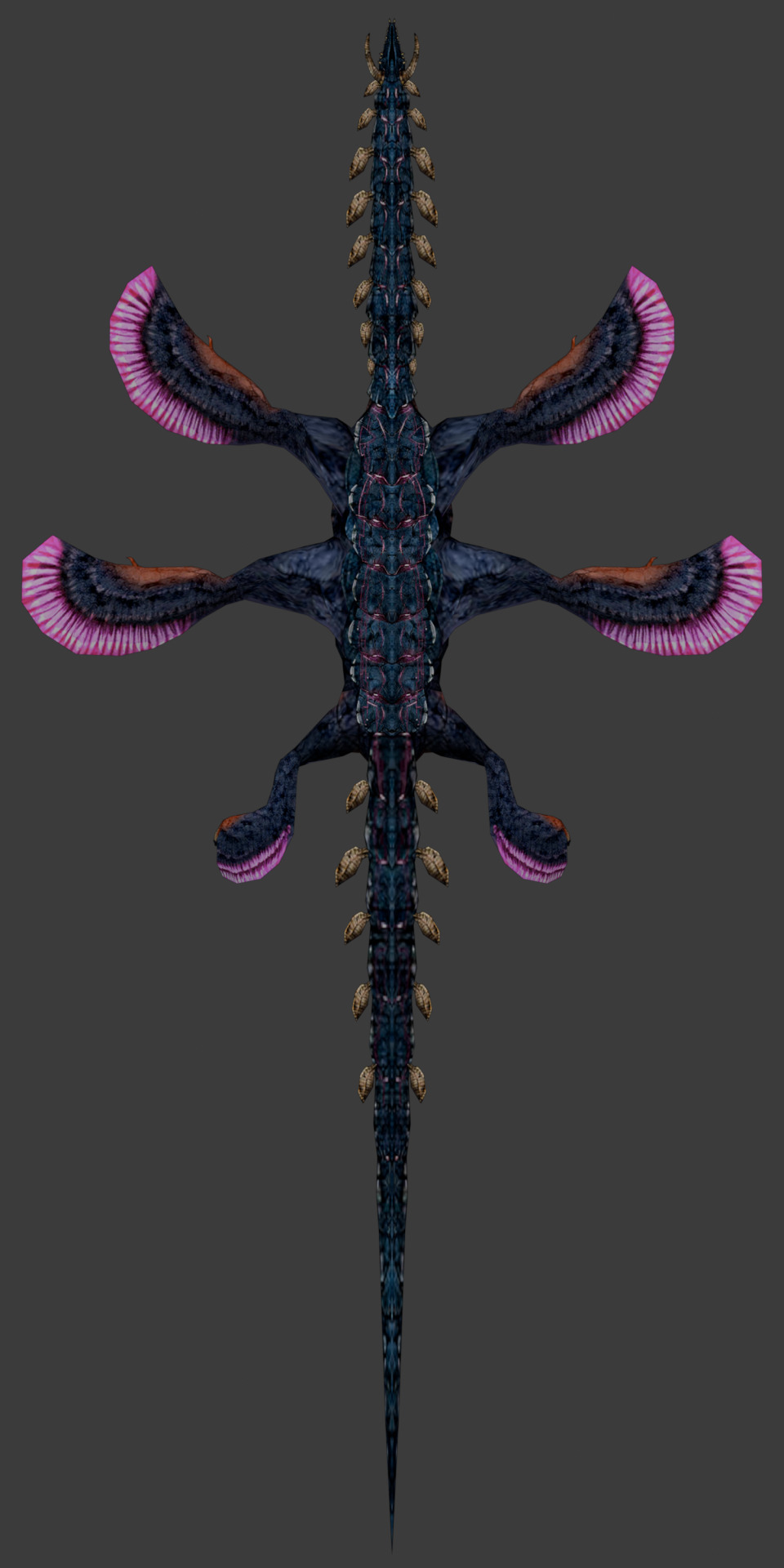
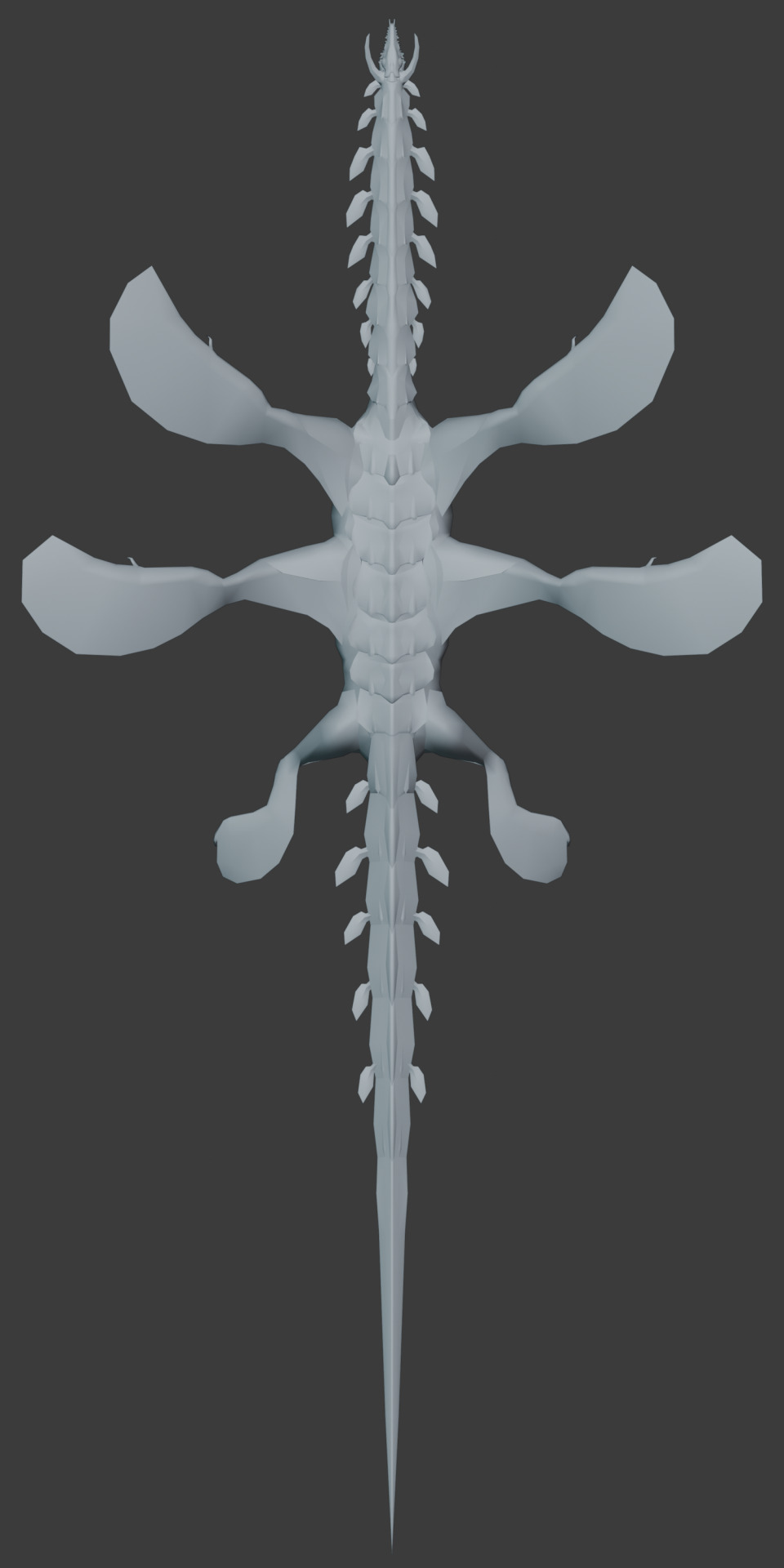
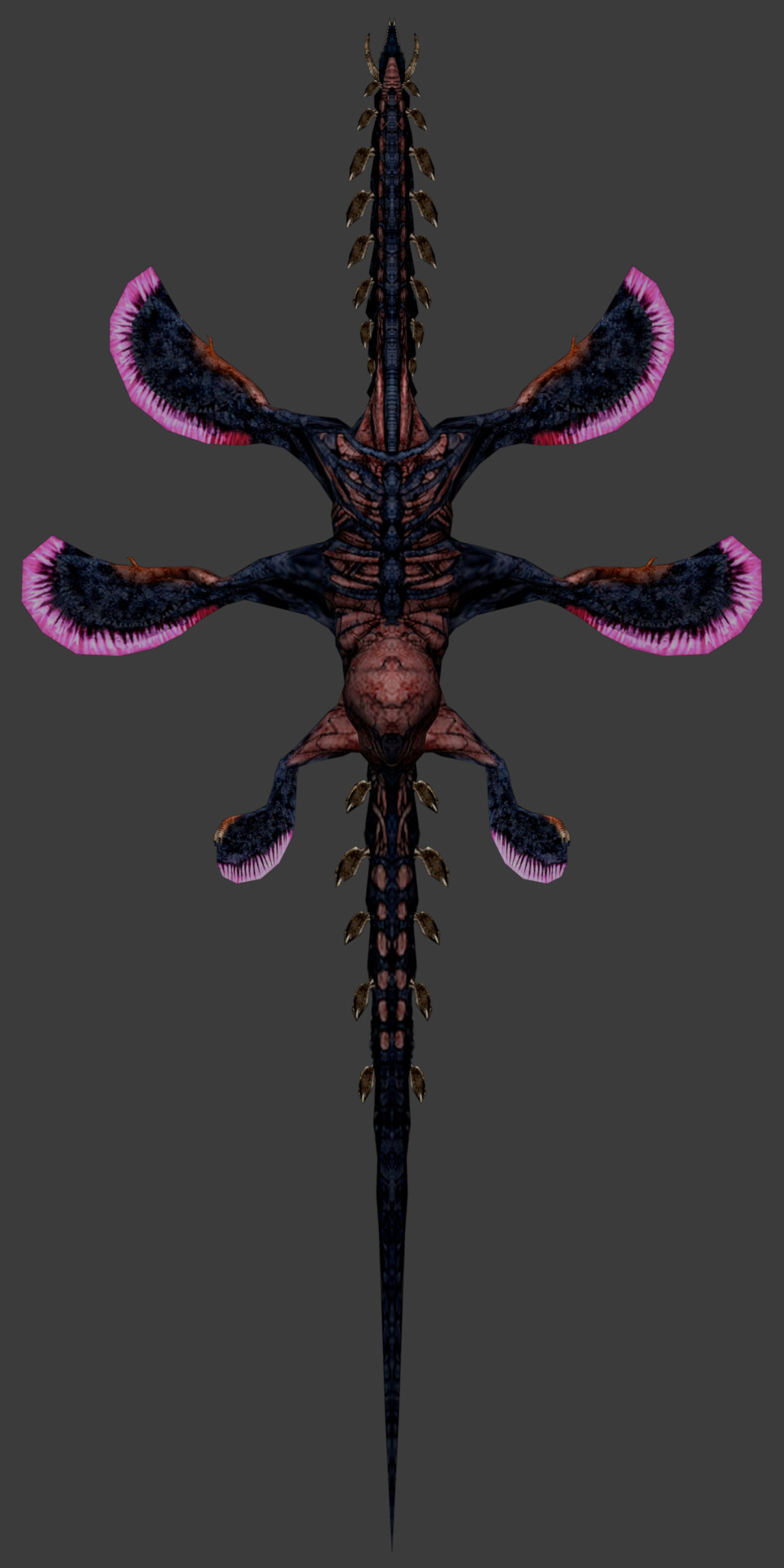
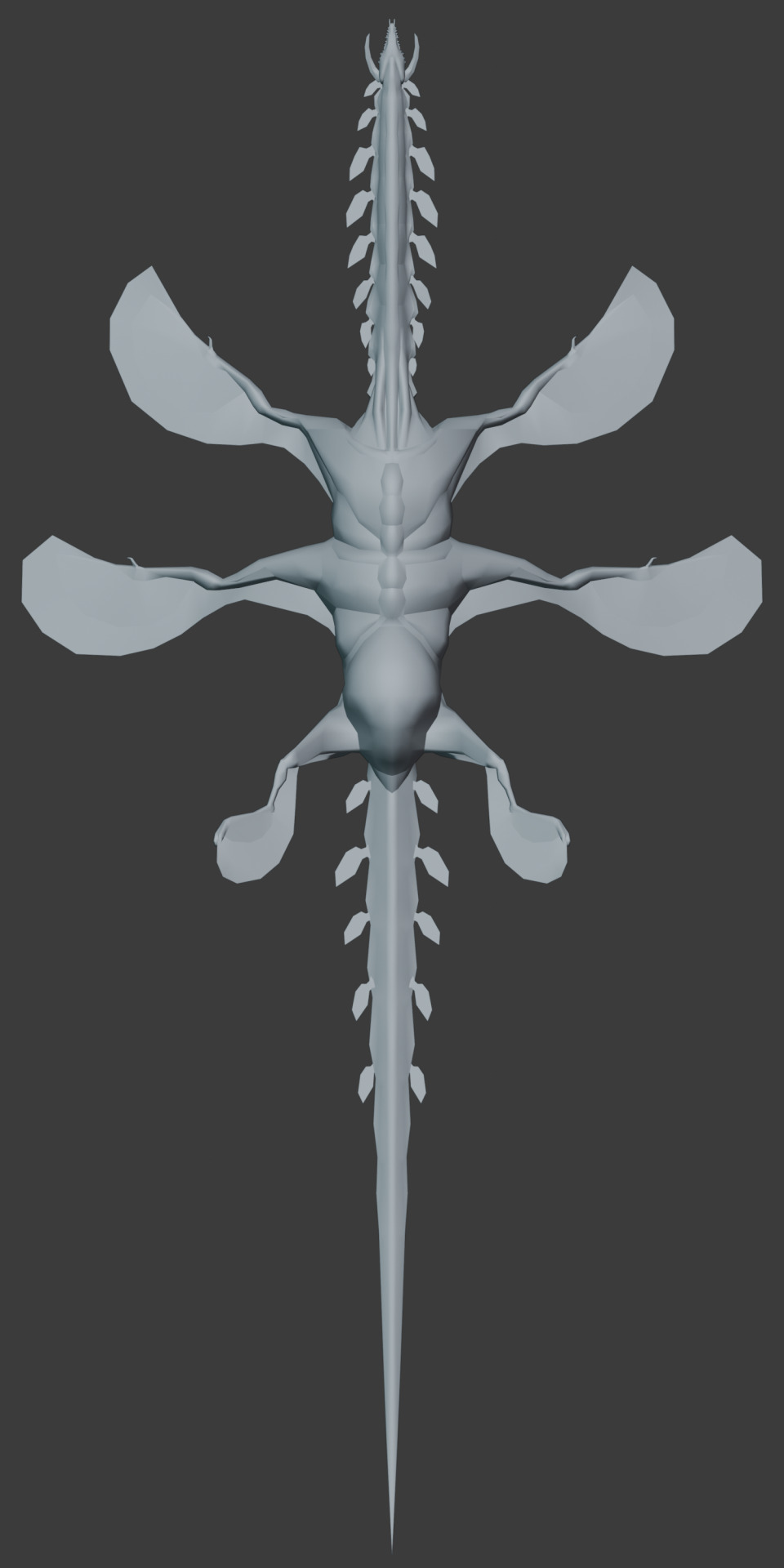
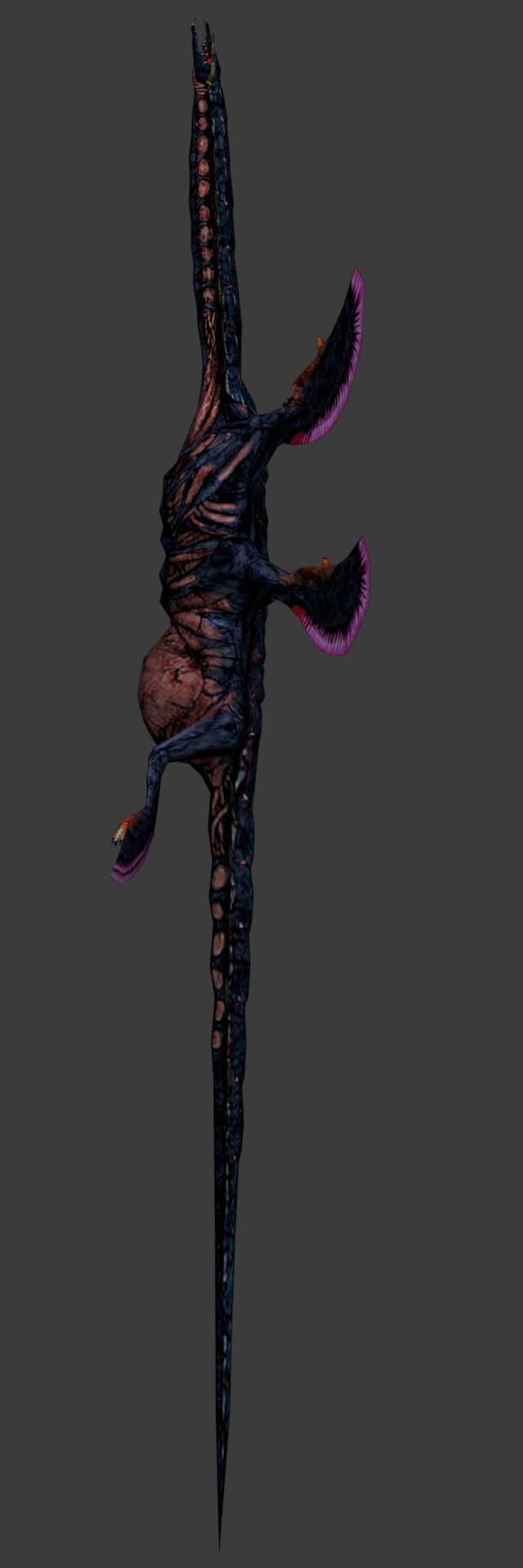
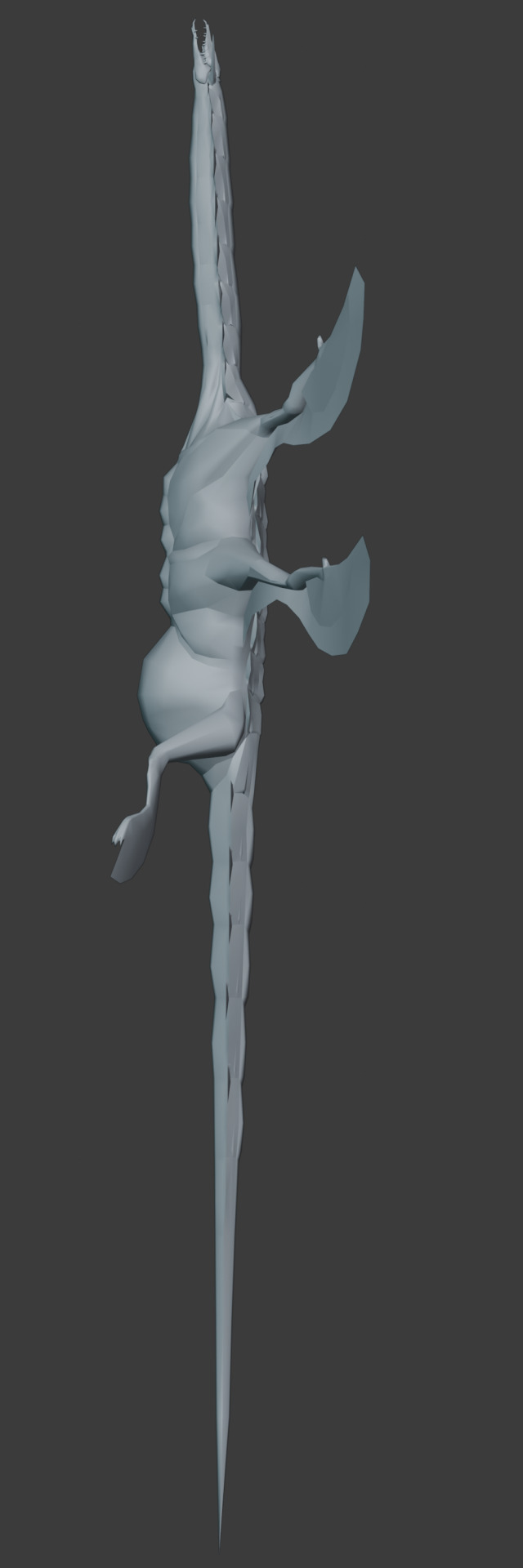
Facial Shots
At first I'd assumed he had a pair of pharyngeal jaws like an eel, but upon further visual inspection I believe his cranial anatomy is far stranger than even that. There's no apparent gums or tongue inside the exterior jaw, and no musculature or soft tissue connecting the outer cranium to the outer jaw at the corners of the mouth; those features are confined solely to the inner pair of structures. And his lower external jaw isn't even connected to the flesh of his neck! I won't know for sure until he allows me to do a tactile exam, but from what I can see, I suspect his entire exterior "face" is actually a specialized defensive structure like the bony plates on his back. Like a big pair of horns, almost. What appears to be teeth may actually be akin to the points on a deer's antlers.
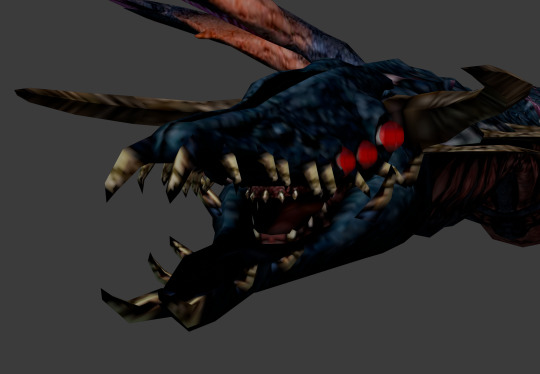
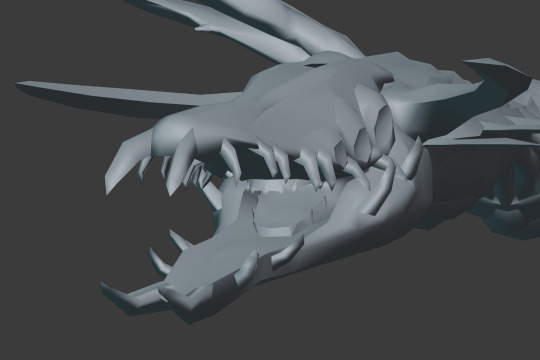
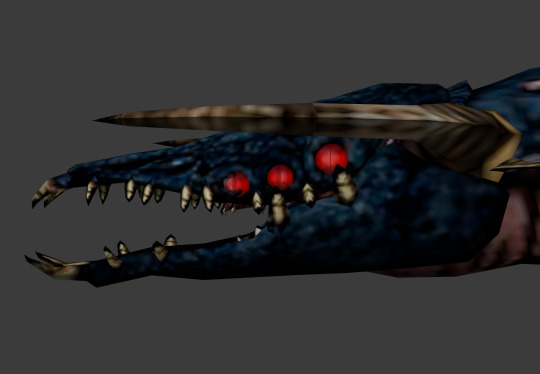
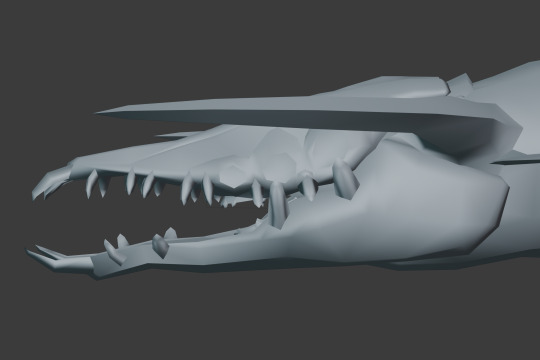
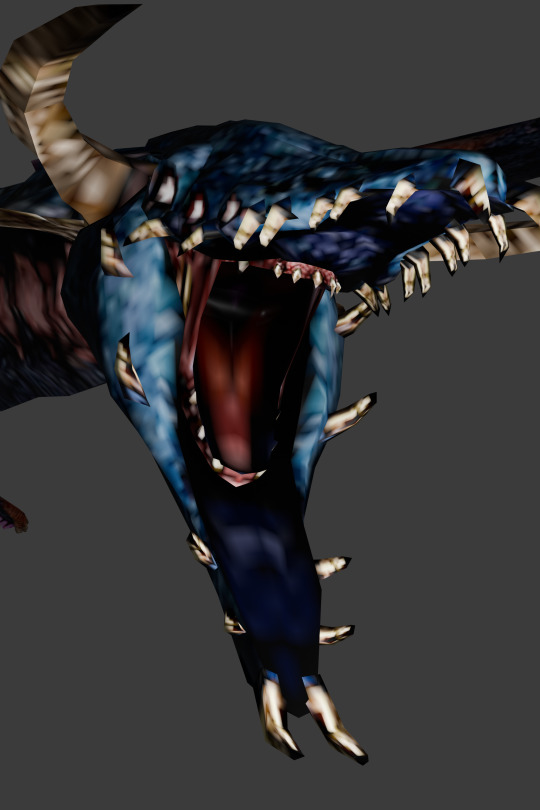
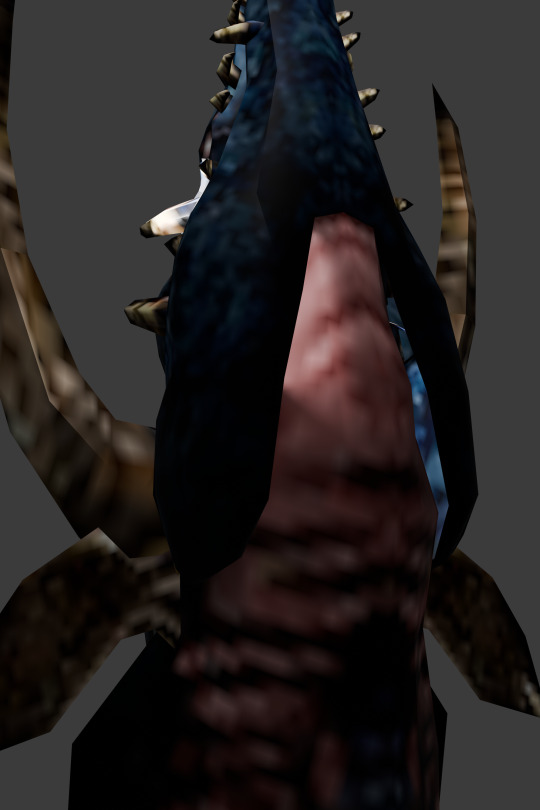
Torso Detail
His body construction really reflects his origins. He almost looks composed of two human rib cages, compressed and stacked atop one another. Complete with two lateral shoulder girdles and at least the appearance of very humanoid chest and back musculature. The range of motion on the joints of his hind limbs is decidedly NOT humanoid, though. I'll have to try to get some focused video shots of them once he's up and about.
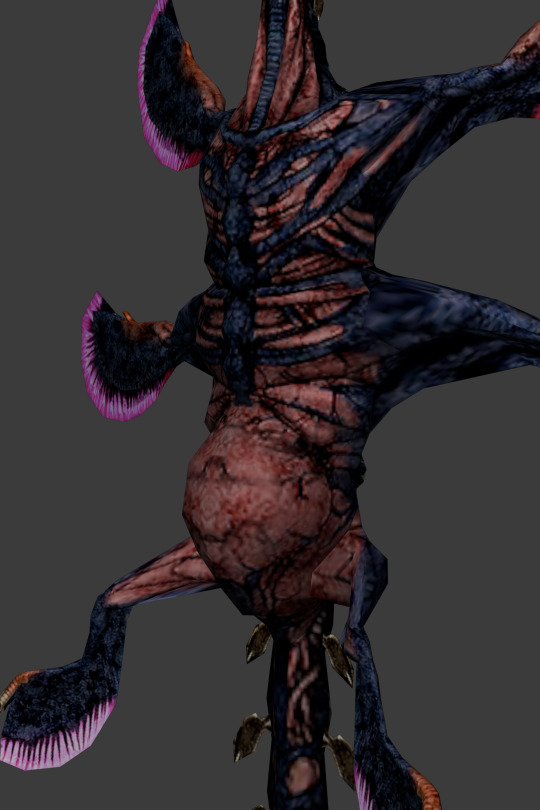
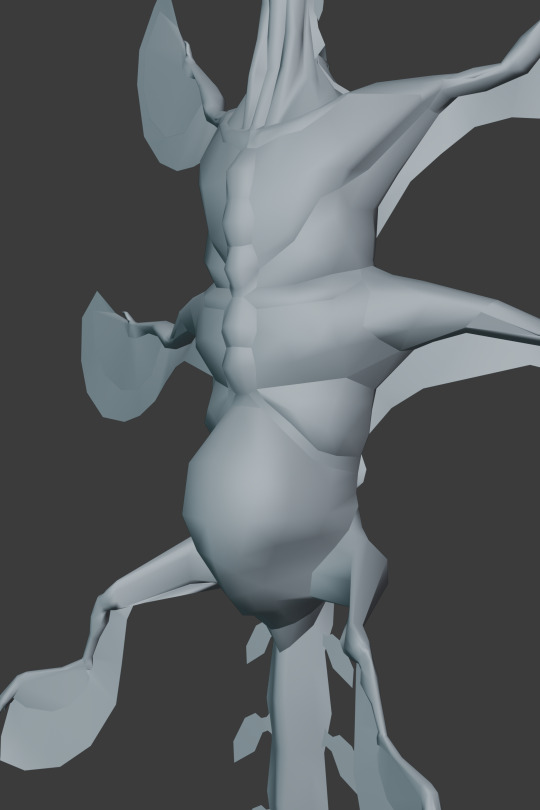
I know we're not SUPPOSED to alter the timelines of the worlds we visit if we can help it, but... I mean, helping him has always been the goal, and the studies were always the excuse. Leaving him here would eat me alive. Maybe if I appeal to Sharena's emotions, and we get Chrom involved...
#fire emblem#fe awakening#grima#grimleal studies#3d art#sort of? i borrowed all the assets from the og games i'm just posing them for funsies#my summoner's adoption of baby grima continues#Youtube
72 notes
·
View notes
Text
An Exploration of Plurality, Simulation Theory And Human Cognition
0. Introduction
I initially set out to compile evidence for the existence of endogenic and non-DID/OSDD plurality. In the end, what I came away with was an understanding of human cognition that has largely been overlooked by singlet psychologists.
I will preface this by affirming that I am not a psychologist myself, and should not be taken as an authority. I would recommend reading the sources themselves. The majority are peer-reviewed articles, though I'll admit that I may have gotten lazy with sourcing in a couple places.
At the same time, remember to separate findings from opinions. Keep in mind that singlet psychologists are looking these phenomena from a singlet point of view, meaning evidence they find of autonomy in certain phenomena will be dismissed as an "illusion of autonomy" or something similar. Pay attention to the data, experience and research reported beyond the singular-normative biases.
I'm going to apologize in advance if any feels the language used is dehumanizing. My personal belief is that all headmates are individuals and their own people. My use of terms like "model" and "simulation" is to try to articulate the underlying mechanisms I believe the brain uses to create multiple consciousnesses. It is not to try to de-person anyone.
1. Defining "Plurality"
Before going further, we need a working definition of what plurality actually is so we can determine what types of phenomena would fall under the umbrella. Wikipedia refers to multiplicity as "the psychological phenomenon in which a body can display multiple distinct personas."
Personally, I disagree with the definition of the body "displaying" personas. It doesn't account for the fact that many headmates exist prior to the first time they front, and can exert control over mental simulations (imagination) and the host's emotions (passive influence.)
I prefer the Multiplicity wiki, which refers to it as "the state of sharing a body/mind with others." But "others" is overly broad while the former definition was too specific. With this in mind, I would use a the following definition of plurality:
"The phenomenon in which multiple independent and autonomous agents occupy the same mind/body."
These agents should theoretically be able to learn and grow over time and refer back to past interactions, as if developing their own autobiographical memories. They should appear as intelligent individuals with some level of self-awareness and be capable of passing a Turing test. (Rather than just repeating generic phrases, or feeling like you're talking to Cleverbot.)
Note that I am focusing on "plurality" which is an endo-coined term rather than "system." While I personally am on the side of non-DID/OSDD plurals using the term, this is going to be a red herring that's irrelevant to the actual point of this post, which is demonstrating that "plurality" exists outside of DID/OSDD.
2. Certain Hallucinations As Medically Recognized Plural Experiences
With that definition out of the way, I'd like to discuss another potential form of plurality that is medically recognized. That is, hallucinatory characters. I think it should be stated that not all hallucinations are inherently autonomous agents. But in many cases, they are, which would meet the criteria for a plural experience. From one study:
Novel findings from our study include the extent of AVH trying to control behaviour and emotions, the experience of AVH as an entity with complex social interactions and voices being imposed on individuals and occurring with multisensory additional factors.
Although voice authority was a feature from our primary data, this was a nuanced and more complex experience whereby voices were trying to gain authority and power through extensive and complex social interactions: manipulating comments, mocking, tricking and blaming. Emotional content is suggested as a discriminating feature of AVH in psychotic disorders by Daalman et al.
And given how frequently DID might be misdiagnosed as psychosis, and how antipsychotics have been known to sometimes negatively impact communication in some systems, connections between psychosis and plurality need to be discussed.
I want to note that just because both might qualify as plural experiences, that doesn't necessarily make the phenomena connected. It's entirely possible for different unrelated psychological phenomena to result in similar experiences. Both can be plural, but not necessarily related to each other.
However, I think there's sufficient evidence that they might be.
It wasn't long ago that a psychotic system asked my opinion on the relationship between psychosis and plurality. At the time, I drew a couple important distinctions between experiences based on what I had head from systems with psychosis. Psychotic hallucinations are hallucinatory. They can be seen and heard as if they were real. They also should just be hallucinatory. They wouldn't have their own emotions like an actual headmate would, nor be able to exert passive influence over the host. In contrast, a headmate would communicate entirely with a mind voice and have their own emotions.
Those assumptions, after further research, proved incorrect, forcing me to re-evaluate my position. Since these are fairly common misconceptions, I would like to correct them now.
3. Can Modern Psychiatry Actually Differentiate Between Non-Fronting Headmates And Hallucinations?
"The Representation of Agents in Auditory Verbal Hallucinations" explores the presence of agents in hallucinatory experiences.
It breaks down hallucinatory experiences into the following 4 categories:
Absent or functionally absent agency
Agency without individualisation
Internally individualised identity (anonymous ‘incognito voices’ or those given purely internally generated names)
Externally individualised identity (whether fictional or real)
It is important to note that types 3 and 4 make up the vast majority of reported voice hearing experiences (Bell, 2013). Indeed, Corstens and Longden (2013) recently reported that representation of an individualised agent could be formulated in 80% of clinical voice hearers.
So, 80% of clinical voice-hearers interpret these voices as individualized agents of some kind.
More importantly, from this paper, not all auditory hallucinations are actually auditory in nature. It cites two examples of this:
It speaks to me all the time, said one of them, it told me that it is necessary to go and ask the Pope for a pardon.—Do you know who speaks to you?—No, I don't recognise it, it is not the voice of anybody.—The voice is it far or near?—It is neither far nor near, one would say that it is in my chest.—Is it like a voice?—Not really, it is not a voice, I do not hear anything, I sense that I am spoken to.
...
It's hard to describe how I could ‘hear’ a voice that wasn't auditory; but the words used and the emotions they contained (hatred and disgust) were completely clear, distinct and unmistakeable, maybe even more so than if I had heard them aurally.
So not only does this prove my initial assumption that hallucinated voices are experienced as actual voices wrong, it also shows that people experiencing these "hallucinations" can feel the emotions of the hallucinated agents. The paper also delves further into how communicatory hallucinations can be felt by deaf patients.
You can find results from the survey here.
10% of participants reported purely ‘thought-like’ voices with no acoustic properties, and a further 40% reported ‘mixed’ voices that had both thought-like and auditory characteristics. These findings challenge the view that hearing voices is necessarily a perceptual or auditory phenomenon, and may also have implications for future neuroscientic studies of what it is happening in the brain when people ‘hear’ voices.
That brings me to the question of whether our current understanding of these phenomena can even differentiate between a hallucination and a non-fronting headmate. When looking for information of how DID is differentiated from psychosis, I found an article with the following quote:
For psychoanalyst and writer Valerie Sinason, the differences are there, though subtle: the voices her clients with DID heard came “from inside and not outside,” manifested from their most repressed traumatic memories. Disordered thoughts were not consistent, surfacing only at certain times, and time and place distortions only manifested when her patients dissociated into other identities. Crucially, it was trauma that defined her clients, and distinguished them from those with Psychotic Disorder.
That seems like a somewhat useful distinction between voices in DID and psychosis at first glance. Except as we established, voices in psychosis are not always reported as external. Furthermore, the DSM acknowledges that some forms of spiritual possession (which would include a delusional belief by the alters that they're spirits possessing the body) could be perceived as external agents.
And while DID almost always has some trauma holders, many alters in DID will not actually be traumatized, and have been known to form as a result of fixations and other reasons.
Even the relationship to trauma isn't consistent as a differentiator, as psychosis itself can be associated with trauma. From the paper on Agent Representation:
In a related manner, there might be a connection between the agent represented and the distressing nature of the voices. For example, Badcock and Chhabra (2013) show, in a comparison between clinical and non-clinical voice-hearers, that the perceived identity of the voice correlates strongly with the distress caused. Furthermore, the fact that a history of childhood sexual and emotional abuse, but not physical abuse, is linked to the likelihood of AVH, may suggest a connection with relationship trauma (Bentall et al., 2012).
All of this is to say that the relationship between hallucinatory mind-voices and non-switching-related experiences of DID systems is complicated at best.
The complication is confounded further in the case of many systems who also experience psychosis and schizophrenia, some of which have reported forming headmates and alters as a result of hallucinations.
For those who want to see more on the subject, this paper goes much more in-depth into similarities and distinctions between the disorders and why DID is commonly misdiagnosed with Schizophrenia or unspecified psychotic disorders. To summarize though, almost every diagnostic rule has a number of exceptions that make diagnosis infinitely more complicated.
Going back to the original question, if "alters" could form but not front of have memory separation, would psychiatrists be able to accurately tell the difference between them and a seemingly-intelligent mind-voice hallucination, if any such distinction exists at all? Based on everything we've seen here, I believe the answer is no.
4. Mind Reading, Simulation Theory, And Agents Recognition In Psychosis
Mind Reading refers to our innate ability to understand and intuit the beliefs, emotions and feelings of others. One popular theory for how mind reading functions is Simulation Theory.
ST (in its original form) says that people employ imagination, mental pretense, or perspective taking (‘putting oneself in the other person’s shoes’) to determine others’ mental states. A mentalizer simulates another person by first creating pretend states (e.g., pretend desires and beliefs) in her own mind that correspond to those of the target. She then inputs these pretend states into a suitable cognitive mechanism, which operates on the inputs and generates a new output (e.g., a decision). This new state is taken ‘off line’ and attributed or assigned to the target.
In essence, when you are intuiting the opinions and feelings of others, you create a temporary simulated state of the people you're attempting to intuit, real or fictional, and assume the state of that model to put yourself in their shoes.
How is imagination useful for third-person mind reading? If you seek to predict someone’s decision—for example, the choice of a main dish by your dinner companion at a restaurant—how could you use imagination to make this prediction? The first step is to put yourself in your target’s shoes, or take her ‘perspective’. Taking someone’s perspective here means adopting, as far as feasible and in light of what you know about her, the mental states she starts with. This includes her preferences about food in general, what she liked at this restaurant on previous occasions, how hungry she is on the present occasion (did she have a light lunch, no lunch, or a heavy lunch today?), and so forth. Using the imagination, you can simulate being in her various dinner-relevant states. Such pretend states can then be fed into your decision-making mechanism, which generates a decision to order a particular main dish. Having used this simulation process to generate a (pretend) choice, you don’t order this dish yourself but attribute the choice to your companion. Thus, the attribution is based on imagination-driven simulation
In these cases, this is referring to a short-term simulation built on past interactions. These simulations are only temporarily formed and would be immediately deconstructed. A related theory to this and psychotic hallucinations is presented in Rethinking Social Cognition in Light of Psychosis: Reciprocal Implications for Cognition and Psychopathology.
In particular, social agent representation (a) is present to differing degrees of complexity throughout development; (b) involves the capacity to internalize models of social actors including their physical and psychological attributes and requires these representations to be maintained and updated through implicit and explicit learning; (c) can involve representations of differing specificity and complexity—from individualized to general, from sparse to rich; (d) is used in both “online” and “offline” social reasoning to predict behavior (i.e., during live social interaction and when the agents being considered are absent); and (e) could be drawn on for reasoning about described, notional, or hypothetical individuals as needed.
These are the bullet points of the theory. I would highly advise checking out the whole paper, as it's well worth the read. This builds off of simulation theory, while not directly referencing it by name. But it also is describing a more complicated phenomena at the same time. The models created in hallucinatory experiences are often long-term simulations that save memories rather than short-term simulations.
If we were to apply simulation theory to the creation of headmates, it could explain why headmates are often based on other people. Fictives, Factives, Introjects, etc. And with false autobiographical memories from those characters' histories. This is something most theories of plurality don't really cover or address in detail.
4.1. A Note on Agent Models and Agent Simulations
From here on out, "agent model" is used to refer to data saved about an agent, physical or otherwise, in long-term memory. It's essentially a file of that agent's characteristics.
In contrast, an agent simulation is the model being ran by the brain as a program. To use a computer analogy, if you downloaded a chatbot to your computer, it is saved in storage as a file (model). When you open that model and begin speaking to it, and it starts using the computer's processing power, the model becomes a simulation. A model is only a simulation while the brain is processing it.
5. "Imaginary Companions" As Non-Pathological Hallucination-Like Plurality
From the previous article:
In middle childhood, from approximately 4 to 12 years old, explicit reasoning about social agents emerges and develops (mostly studied as “theory of mind”) as does the experience of illusory social agents. In a large sample of children between the ages of 5 and 12 years, approximately half reported having interacted with imaginary companions, and evidence suggests that children are able to integrate physical characteristics and personality into their models of imaginary companions with “whom” they have conversations. It is worth noting that the presence of imaginary companions has been found to be associated with both the tendency to hear words amid a sound stimulus of unstructured phonemes and better social cognitive development in terms of representing and understanding others’ mental states even in children at high risk for developing problem behaviors. In contrast, imaginary companions associated with negative psychiatric outcomes are typically not experienced as under voluntary control or remain beyond their typical developmental period in middle childhood, suggesting an altered developmental pathway that affects social agent representation.
One study into the autonomy of imaginary friends reported that in mixed relationships, about 50% of children with imaginary friends would report the imaginary friends being "in charge" of their relationship.
Although most children in positive relationships, regardless of friend type, said that neither was in charge, children in positive imaginary relationships were more likely to say that they were in charge (35%) than children in positive real relationships (4%). There was not a significant difference regarding friend type for children in mixed relationships. For the simple effects of friend valence, children in mixed imaginary relationships (M = −.29, SD = .18) responded to this question significantly differently than children in positive imaginary relationships (M = .25, SD = .14), p < .001. In the case of mixed imaginary relationships, 50% of the children said that their friend was in charge, compared to 5% of children in positive imaginary relationships. There was not a significant difference regarding valence for children in real relationships. In summary, regarding responses to the “Who’s in Charge?” question, we see differences in positive imaginary relationships and positive real relationships, but not between mixed imaginary relationships and mixed real relationships. We also see differences between positive versus mixed imaginary relationships, but not between positive versus mixed real relationships.
Additionally, children would report that they had the ability to "make their friend be nice to them" at about the same rate regardless of whether the relationships were with imaginary friends or physical ones.
Predicted values indicate that younger children and those in more mixed relationships (Friend Score) were more likely to say that they could make their friend be nice. These data suggest that young children and those in more mixed relationships are more likely to report that they can make their friend be nice to them than older children and those in positive relationships. Of note, relationship type—be it real or imaginary—did not significantly predict whether children believe they can they make their friend be nice to them.
There is also a strong correlation between Imaginary Friends and DID, with many imaginary friends becoming alters.
6. Other Advanced Long-Term Autonomous Models
Writers commonly experience something similar to this.
The most common form of dialogue with characters reported by our sample involved the writer speaking with a character directly (15%), with the character as a separate imaginary interlocutor. In some cases this form of dialogue was described as infrequent, or other forms were reported as being more common:
They sometimes tell me that what I have in mind for them isn’t right – that they would never behave or speak that way. I don’t usually answer back. (R 150)
I can ask them questions and they’d answer as if without my input, I haven’t done it much but when I do it works just as a normal conversation would do often times they do go off on a tangent. (R 29)
One writer describes the following experience:
My characters need to feel separate for me to hear their voices, which also means that when I’m trying to ‘put words in their mouth’ instead of listening they often talk back. And then we discuss things until I find what they would say. If I’m really stuck on the emotional transitions in the story, then listening to what the characters want to say is extremely important. […] I write in a way that’s equivalent to method acting: I have to be the character before I know what to write… and before I can listen to them as separate people in my head.
This makes sense with agent models and simulation theory, as a large part of writing is programming parts of your brain to be able to accurately simulate the emotions of other people. The characters of writers will often be advanced and elaborated modes.
Another practice is speaking to gods and spirits. The Vineyard Evangelicals employ a specific variation of prayer to learn how to speak to God and hear him talk back in turn.
These tests, or expectations, were commonly described as “discernment.” Discernment was an ambiguous, complex process. When a decision was consequential (e.g., was God calling the young couple to move to Los Angeles and away from the man’s family?), it was not uncommon for congregants to spend many weeks praying about the decision and asking other friends in the church to pray about the decision and to talk to them about their prayer experience. Congregants gossiped about people who said that they were following God’s voice but (gossipers thought) were really acting on their own wishes. Yet the expectations were clear. Even if hearing God in one’s mind was complicated, God was speaking and the congregant’s job was to hear.
...
Nevertheless, many said that they had learned to recognize God’s voice the way they recognized a person’s voice on the phone. As one congregant explained, “It’s a different sort of voice. I mean, I know my own voice. If I thought of your voice I would think of how your voice sounds, and if I think of my voice I think of how it sounds, even if I’m not hearing anything. It’s a different tone of voice.” Or, as another put it: “It’s like recognizing someone—it’s like, how do you recognize your mom?” It was acknowledged in the church that each person would experience God in their own way and develop their own patterns of learning to recognize him: some through warm tingling; others through goose bumps; others still through images or impressions or scriptural phrases. “I get a lot of images,” one person explained. Another said: “I rarely see images. When I pray for people I get sensations that I can in turn translate into words. ... Like more than seeing the bird, you feel the flight of the bird.” Congregants were insistent that one could learn to identify God. “It gets to a point you just know it’s God’s voice. It’s very snappy and comes with constant prayer just non-stop.”
The study showed a strong correlation between these experiences and the Tellegen Absorption Scale. As the article explains, Absorption is heavily tied to dissociation.
Tellegen first set out to develop the scale as a pen-and-paper measure of hypnotic susceptibility. In the end, the scale correlated only modestly with the current gold standard measure of hypnotic susceptibility, the Stanford C (Nadon et al. 1991; Whalen and Nash 1996). Yet the Dissociative Experiences Scale, probably the most widely used measure of dissociation, bases a third of its items on absorption. (Another third measures amnesia and the final third measures depersonalization.)
Absorption is also heavily correlated in both Psychosis and Tulpamancy.
7. An Overview of Modern Tulpamancy And Headmate Creation Practices
Modern Tulpamancy is the practice of intentionally creating headmates using methods very similar to those of the Vineyard churches in speaking with God. One of the most common methods is narrating, talking to a mental entity. At the same time, you listen to or feel for a response that doesn't seem like your own. This response is then attributed to the mental entity. This continues until it is elaborated enough to develop complete autonomy and sentience.
However, not all tulpamancers actually intentionally use these methods. Often, headmates identifying as tulpas will be imaginary friends from childhood, or fictives based on characters from works of others or the creator's OCs (like me.)
Several Tulpamancers (from both psychological and metaphysical communities) report having had sentient imaginary friends for up to several years before finding out about Tulpamancy. For one informant, the practice had been established in her family for several generations. Many Tulpas from the psychological tradition, when interviewed separately from their hosts, also claim to have ‘been around’ in their hosts’ consciousness before their hosts became aware of them through Tulpamancy.
Unlike the imaginary friends of children, the Vineyard God or hallucinations, tulpas display the ability to "switch" with their hosts. Unlike with DID, switching with tulpamancers is a learned skill with numerous guides on how to do it rather than an instinctive reaction.
So, what does this mean?
8. The Self As A Simulation
I imagine that some of these articles and conclusions may have seemed invalidating to some, suggesting that alters and other headmates are just imaginary models and simulations. But I'd like to suggest that the self, as a whole, even in singlets, is a similar model that is being simulated while the host is conscious.
It's important to note that humans aren't born singlets. They also aren't born plural. They're born, what I would call, null.
Toddlers only start gaining a sense of self around 18-24 months. This is around the same time that they begin developing empathy for others, strongly suggesting a link between them beginning to create other-models and self-models.
One paper on the neuroscience of mentalizing linked the process primarily to the paracingulate cortex. However, related areas of the brain also activate during self-thought.
There are, however, several studies in which this region of the medial prefrontal cortex has been activated by tasks that did not involve thinking about the mental states of other people. For example, activation of this area is seen in studies of emotion [33], especially when volunteers are asked to reflect upon the emotions they are currently experiencing [34,35]. These tasks also involve mentalizing, except that it is our own mental states rather than those of other people that have to be represented. The paracingulate cortex has been activated in imaging studies involving many forms of this kind of self-monitoring: visual self-recognition [36], autobiographical memory [37,38],verbal self-monitoring [39], self-generated thoughts [40],externally produced tickling [41], and perception of pain[42]. Gusnard et al. [35] have noted that the paracingulate cortex is active during the ‘rest’ condition in many studies of cognitive processes. They speculate that this might reflect a ‘default’ mode of functioning in which we think about ourselves when there is nothing external to attend to. It is well established that the ACC has a role in directed attention. Perhaps its most anterior section is specialized for directing attention to mental states.
All of this brings me to the following theory: The singlet self is a "model" created the exact same way as models of others. A singlet creates a model of themselves as a toddler at the same time that they form models of "mom" and "dad" and other people in their lives.
8.1. Internally-updated models vs externally updated models
I would propose that one fundamental difference in these models is that models of other people are primarily externally updated, while models of self are internally updated. That is, if you decide internally that you like chocolate, that becomes part of your internal self-model. You might project this onto your models of others. "I like chocolate, so everyone likes chocolate." But when presented with external evidence to the contrary, that model will be updated. "My mom says she doesn't like chocolate, so she doesn't like chocolate."
Imaginary friends, on the other hand, are examples of internally-updated models. They ARE the models your brain creates, in the same way that you are the model your brain created.
Autobiographical memories are thought to play a fundamental role in your sense of self. A purely externally-updated model will not form memories based on simulations, because the simulation is reset and recreated with each interaction of the simulation, based almost entirely on external data. When you imagine speaking with someone you regularly speak to, you are going to be drawing primarily from the non-simulated interactions you've had with them. The simulated interactions will not be part of the memories of these models.
In contrast, internally-updated models save memories from internally-simulated experiences. That allows them to gain experience with repeated interactions and elaboration, eventually developing a sense of self and autonomy. The mechanism for this appears the same, whether imaginary friends, intelligent hallucinations, gods, alters, or a "core" self.
I also might speculate that some delusions could be a result of the brain misattributing the actions of internally-updated models to externally-updated ones. (Imagining a relationship with someone you never met, and then believing the physical person has feelings for you as a result.)
8.2. Not Always A Clear Dichotomy
Many internally-updated models can also be affected by external observations. A God model may attribute good fortune in your life to his divine blessings. A fictive may change based on additions to their sourc's canon. And most notably, a singlet will often experience "choice blindness," where when presented with a situation where they're told they made a choice they didn't make and wouldn't have made, they will defend the choice as if it's something they had actually done.
I believe the above phenomenon of choice blindness, where external information overrides internal information about the self, further supports the theory that our self-model is operating on the exact same cognitive processes that we would use to judge other people by. When met with conflicts between the self-model and the perceived reality, the brain will sometimes adjust the self-model and memories to fit with the perceived reality, just as it would when evaluating our models of other people.
9. The Front As A Revolving Door and Dissociative Identity Disorder
All of this has led me to a re-evaluation of DID and "alters," which I'm sure is going to be controversial but is built on all the previously-presented studies.
Most psychologists focus on DID as the mind creating other "selves." But this always approaches alters as being parts or identities or masks, rather than as independent agents first, with a heavy emphasis on switching and less so on hallucination-like experiences. I'd like to suggest, alternatively, that alters are other internally-updated models, like the singlet "self." Most of these models are created through a natural process that most people are capable of creating and updating to the point of gaining self-awareness.
That said, DID itself is clearly not something that happens naturally, and is virtually always an environmental response to severe trauma. At this point, I think we need to look into how DID/OSDD forms and how it differs from the other forms of plurality I've discussed here.
From the Mayo Clinic:
Dissociative disorders usually develop as a way to cope with trauma. The disorders most often form in children subjected to long-term physical, sexual or emotional abuse or, less often, a home environment that's frightening or highly unpredictable. The stress of war or natural disasters also can bring on dissociative disorders.
Personal identity is still forming during childhood. So a child is more able than an adult to step outside of himself or herself and observe trauma as though it's happening to a different person. A child who learns to dissociate in order to endure a traumatic experience may use this coping mechanism in response to stressful situations throughout life.
I would propose that this can manifest in multiple ways. In some cases, the child may imagine they're someone else while enduring trauma, essentially switching in an existing model. (That model may or may not already have an elaborated sense of self with autobiographical memories by this point. Some DID systems I've encountered report plurality prior to trauma.) In others, they may just leave front completely vacant or with a "blank" model.
In the latter case, continued switching to that blank model, with it gaining memories each time, results in the model gaining sentience and a sense of self.
But there's more happening here than just the creation of an alter. Imagine front as a revolving door. This door allows the self-model to connect with and pilot the body. Dissociation is the self moving through the door from front to back, allowing a new model to take its place. (Or multiple models, in the case of co-fronting and blending.)
For the tulpamancer, switching is a skill that requires you to learn how to make the door revolve. The tulpamancer and other forms of non-DID/OSDD needs to learn how to move to back, and the tulpa needs to learn how to control the body.
But the brain learns to do things easier the more they're done. If trauma trains your brain to switch when encountering certain triggers, that's going to make switching an automatic and difficult-to-control reaction. Essentially, this results in a malfunctioning door.
DID also forms before a "core" is sufficiently developed. In non-DID/OSDD systems, the core often serves a gatekeeper-like role, being able to control switches. Without a developed core, agent models are closer to equals, and the internal mechanisms responsible for regulating the door aren't functioning properly. Taken together, this results in disordered switching and dissociation.
Another thing simulation theory might help explain in relation to DID is the mechanisms inter-identity amnesia. When you simulate a conversation between two models, these short-term simulations are created with an assumption that they can't read each other's thoughts, nor those of the agent who is running the simulation. This is a necessary aspect of theory of mind, and understanding that other people may not know everything that you know.
Separation of memory among different internal models is another natural human ability that becomes malformed in DID as a defense mechanism against traumatic memories. (Although it also likely be tied to state-dependent memory.)
10. Autigenic?
A disproportionate amount of tulpamancers report Autism Spectrum Disorder. Many endogenic systems self-identify as "Autigenic." One common explanation for this is that part of Autism is a tendency to hyperfixate on characters. But following up in the memory separation between internal models present in people with DID, I think another potential relationship needs to be explored.
Children with ASD often have severe difficulty with false belief tests.
This could signal trouble separating the simulated minds of internal models, making it more likely for an elaborated internal model to gain unwanted access to the host's thoughts, and subsequently gain self-awareness. This could be part of why people with ASD are more likely to be diagnosed with Schizophrenia and other psychotic disorders.
Evidence for this is far from conclusive, but worth considering as we move towards a more unified understanding of the nature of plurality.
11. Summary
In conclusion, based on this evidence, I believe human cognition and theory of mind is based on the ability to create multiple "models" for predicting human behavior. Most singlets create a self-model around 18-24 months at the same time they create models of other people.
Models based on other people are updated based on external information and experiences, and do not form autobiographical memories based on internal experiences. Meanwhile, self, hallucinatory, spiritual and imaginary friend models are updated based mostly on internal information.
These internally-updated models build autobiographical memories based on internal experiences and become more elaborated the more the brain simulates them, to the point of eventually reaching self-awareness.
DID is caused by a trauma-defense mechanism in early childhood that results in unstable switching and memory separation among other internally-updated simulated consciousness models.
All-in-all, I believe that singular-normative society has obscured an integral function of the human brain that psychologists have only just began to scratch the surface of. I also want to thank everyone who has shared their own experiences with me and helped me gain a better understanding of the phenomena.
Finally, this is not intended as a definitive theory on plurality. It's a starting place, and I am open to adding to it and revising it as new information is presented.
Thank you for reading. ☺️
#psychology#psychiatry#plurality#endogenic#mental health#psychosis#syscourse#system#multiplicity#plural#simulation#actually plural#system stuff#schizophrenia#actually endogenic#endogenic system#actuallyplural#actuallymultiple#actuallyendogenic#pro endogenic
136 notes
·
View notes